SEO
Women In SEO Share Tips On Closing The Wage Gap

We’re back this Women’s Day with even more tips and advice from women in the SEO industry on how to know your worth – and command it.
This piece was originally published in 2021. Now, another year into a global pandemic and amid ongoing socioeconomic unrest the world over, our experts have more to share.
And their insights have never been more important.
COVID has worsened global inequality across the board and in America, this has translated to a deepening wage gap – especially for Black, Native American, and Latinx women.
SEO is constantly evolving according to data, consumer behavior, and algorithm trends.
But when it comes to women being treated as equals, the industry is much less evolved.
SEO is still a male-dominated industry where men outnumber women 2-to-1, according to a study conducted in 2020.
That survey found that:
- Women are far less likely to be technical SEO professionals.
- Women are twice as likely to freelance (see: unstable employment) as their male counterparts.
- Men are more likely to charge monthly retainers; women are more likely to get paid by the hour or project.
- Men’s retainers are 28.6% higher than women’s.
- Men’s project rates were on average 66.7% higher than women’s.
- Median hourly rates for men were 16.8% higher than for women.
And while the sample sizes for various aspects of this research were small, it is also worth noting that the study failed to account for the impact of combined gender and racial bias for Black, Indigenous, and other women of color in SEO (which the study coordinator acknowledges and regrets).
Had that been factored in, we would most likely see even more extreme differences in pay and opportunity for those women.
Despite this, many women continue to be attracted to careers and entrepreneurship in SEO and Digital Marketing.
Our world is fun, challenging, and ever-changing.
And as more women become involved in and grow in the industry, the uphill battle those women face is realized by more and more people.
It can be intimidating to ask for the rates we see in industry benchmarks and to prove our value to the companies or agencies who employ us.
In this column co-authored by Stephanie Gifford, SEO Marketing Manager at Adigma.io, we’ve asked women to share their best advice for peers and things they wish they’d known earlier in their careers.
Check out these tips for knowing your value as digital marketing and SEO professionals, getting paid fairly, and defending the title you’ve earned.
Please note that the job titles listed below reflect those of each contributor when they first submitted.
Knowing Your Value As An SEO Professional
Miracle Inameti-Archibong, Organic Performance Lead At Moneysupermaket Group:
“One of the reasons why women fail to ask for their worth is the feeling that they are not good enough. Work on that imposter syndrome.
Keep track of your accomplishments both big and small throughout the year. Don’t wait until it’s time for your review.
Don’t forget to value your soft skills as much as your hard skills it all impacts the work you do and it’s so unique to you, you deserve to be paid for it.”
Sara Taher, SEO Manager At PDFTron Systems Inc.: 
“Being woman wearing a hijab led to my being underestimated in so many situations.
But then I realized, I need to be confident first inside to radiate it from the outside…
Confidence isn’t the same as competence; I know I’m good at my job… and all I need to do is to raise my confidence level to be as high as my experience as an SEO professional…
I’ve been working on that since last year, it’s not an easy journey but I’m getting there hopefully soon!”
Robyn Johnson, Chief Executive Officer Of Marketplace Blueprint: 
“If I know that I am good at what I do, and believe that I provide a product that will make a difference to a client, I am doing them a disservice if I don’t assertively make that offer.
I found earlier on that I didn’t want to ‘pressure’ people, and then those same customers would go purchase with someone who had slick marketing or a more aggressive sales process even when they had less experience and expertise.
Consider who your customers might go with if you don’t communicate your offer and the value you bring to the table.
You aren’t tooting your own horn to gloat or be prideful; you need to accurately highlight your skills and your value so that your customers or potential employers can determine if your offering will really get the results they need.”
Julia McCoy, Coach & Strategist At The Content Hacker: 
“Give yourself an annual task of re-assessing your rates.
Every year, without fail, audit what you charge and increase as needed. You should be charging more as your experience, skills, and credibility/tenure grows.
Don’t let imposter syndrome stop you from claiming your rightful place in the market. Back it up by boldly talking about the work you’ve done, and goals you’ve smashed for clients!”
Chelsea Alves, Sr. Content Marketing Specialist At Rio SEO: 
“As a woman, knowing your professional value not only builds confidence but extends to the work you produce. This in turn leads to higher quality work, increased satisfaction with your job, and likelihood for promotion.
Stagnation can be a career killer. Instead, we must strive to push past our comfort zones.
To do this, I encourage women to continue to enhance your skills, broaden your networks, and ask for mentorship when needed to truly leave your mark in the SEO world.”
Navah Hopkins, President At Navah Hopkins LLC: 
“On general value: Use data! Before you set rates or go into a salary negotiation, look up what others are charging/being paid.
Don’t be afraid to have different rates for different projects and always make sure you’re accounting for overhead (taxes, utilities, software, etc.).
Here’s to all the amazing power women knowing their value and being paid appropriately for our brilliance!”
Jenise Uehara Henrikson, CEO Of Alpha Brand Media, Home Of Search Engine Journal: 
“When in doubt… go for it. Apply for that job, ask for that raise, ask for more $$$ in your proposal.
In the workplace, women in general tend to hang back and ask for less. A recent LinkedIn study showed that women apply to 20% fewer jobs than men.
Another famous study found women feel they need to meet 100% of the job criteria before they will apply… while men usually apply after meeting ~60%.
Women are twice as likely as men to report a total lack of comfort when asking for a raise. We need to ask for more. And when we don’t get it? Instead of giving up, learn to take a different approach, dust yourself off, and try again.
It’s taken me a long time to evolve my reaction to rejection: that it is not a verdict on me and my worth and I should just stop. Rather, I’m learning from failure, so that I can try again, fail better, and eventually… succeed.”
Ivy Boyter, SEO & Content Manager At GYBO Digital Marketing: 
“As someone with HR experience from years ago, your title won’t matter as much as the meat you can put into your resume… the data and results that matter to who is looking to hire someone.
Show what you bring to the table by including valuable measurements in your descriptions instead of the day-to-day activities.
In general, though, titles can help you research what pay ranges you may expect.
There are plenty of websites that will help you discover pay ranges based on position, years of experience, where you live, etc. And I agree with PP… negotiate high (read “Never Split the Difference” if you want to learn serious negotiation skills ).
Finally, if you can’t get the $$, benefits like vacation/PTO are sometimes negotiable for the right candidate.”
Negotiating Rates And Raises: Practical Tips From Women In SEO
Rue Walker, Owner Of Walker Web Consultation:
“I work with small businesses who often have tight budgets.
I always want to respect the investment in my services, so I prepare monthly reports that detail exactly what I have provided and show clear results.
Then, when I ask for a raise, I have a record of success.
I will also offer to work for three months at a lower rate of pay with the option to negotiate a raise to my preferred pay scale once I have shown results.”
Motoko Hunt, President – Search Marketing Consultant At AJPR LLC:
“Show your value in terms of business data, not just because you’ve been there for X number of years or you put X number of hours but because your work grew (contributed to growing) business X% or increased the revenue by $X.
Also, always keep paper/digital records of communications, projects, etc.; whatever proves what you did/said.”
Shelly Fagin, Director, Growth Marketing At Credit Karma: 
“Never be afraid to negotiate if the offer isn’t right for you. I do believe women tend to negotiate less out of fear of being seen as aggressive or demanding.
On the flip side, if someone isn’t willing to give you what you deserve don’t be afraid to walk away.
If the company or client really understands your value, they’ll work with you. If they don’t, you probably dodged a bullet.”
Anna Crowe, SEO Strategist At Hello Anna Branding: 
“Stop giving away your number.
I’ve worked both in-house and in freelance life.
Over the past four years, after talking to my friends about their salaries and rates, I realized how underpaid I was. I would get to the negotiation and lowball myself.
I was following the motto’s of “Hustle hard” and “Slay your day.” But, in reality, following advice from an Instagram quote doesn’t pay your bills.
I realized it’s all about how you finesse the numbers.
First, I came up with my line in the sand of what I needed to make to survive. Then add a little extra ($10,000-$15,000 per year).
When you’re asked for a number, ‘What is your budget?’ or ‘What are your salary requirements?’ Flip the script. Ask your client or potential boss what their budget or salary range is.
You might be surprised with the number you get back.
The first time I did this, I was going to quote $3,000 per month.
By the end of the conversation, I had more than tripled my money. It’s like poker, don’t show your cards. I had undercut my company, my self-worth, and my time. I was just happy to win a client.
Now, I understand my bottom line. And, I’m comfortable saying no, whether it be to clients or a project.”
Robyn Johnson, Chief Executive Officer Of Marketplace Blueprint:
“Don’t base your prices on what you are ‘worth.’ I know that sounds counterintuitive but what if you have self-worth issues? That made me tend to underprice my services.
Instead of focusing on ‘What I am worth?’ I now ask myself, ‘How much value will I bring to this client?’
Focusing on the value I bring to the customer allows me to separate my service fees from how I might be feeling about myself on any given day.”
Bibi Raven, Founder Of Bibibuzz: 
“I think a lot of women have the notion that negotiation has to be confrontational, so they try to avoid going into it full-heartedly.
They also don’t like putting themselves in the spotlight and feel that talking about their accomplishments is a bad thing.
What I’ve learnt works best is this:
Assess your own worth, and then double that (as you’re probably aiming too low, and the negotiation result might end up lower).
Determine your BATNA: Best Alternative to a Negotiated Agreement. This is one of the pillars of the Harvard Method. It means that prior to a negotiation, you determine when you will walk away from the table.
It’s a great safeguard against agreeing to something you’re not comfortable with.
Don’t take it personally. Separate what you do for work and business from your personal worth. Rejection in a negotiation does not say anything about who you are.
Of course, the other party might mean it personally, but you don’t have to play along. Water off a duck’s back.
Be as laidback as possible. The weird thing is, when the other party notices you’re relaxed, they often tend to agree with you. If you don’t know what I mean, watch the movie “Office Space.”
Use “okay, and…” when the other party offers something you don’t want but it’s not quite at BATNA level, create an opening for yourself.
Don’t say no right away, but create an opening by countering with a demand that will make theirs acceptable.
For instance, when they say: we want you to start working full-time, then you say: Hey cool, but I’d like three months paid leave with that.
If you have this idea stuck in your head that you’re simply not that kind of person to ask for things, pretend you’re someone else that you admire and channel them.”
Why Titles Still Matter In SEO
Angie Nikoleychuk, Content Marketing Manager at Search Engine Journal: 
“Titles are as much about your pay and your responsibilities as they are a signal to others.
In the early days of my career, for example, I quickly learned that marketing my services as a “freelancer” seemed to reduce the quality of the jobs coming in and the pay for that work.
It improved significantly after listing myself as a copywriter and content provider.
And while a title can signal your level of experience and expertise to others, that quickly dissipates when you get down to work.
Holding a title doesn’t always equate to the levels of confidence, support, and money you need to do your job.
No matter what title you hold, you won’t be able to achieve great things without a team that supports your efforts and has confidence in your abilities.
It also depends on your ability to speak up and demonstrate your value. Don’t be afraid to brag in a tasteful way and make sure you claim credit for your work.
Women have traditionally been taught to avoid conflict and not make waves, but it’s difficult to stand out if you spend all your time blending in. It pays to be bold in the right moments.
After all, if you’re not comfortable with your work and fail to recognize its value, no one else will. Title or not.”
Libby Stonehawk, Co-owner Of Stonehawk Digital: 
“I seriously undersold myself at the start by calling myself ‘junior’ in my job title and charged way too little, working myself to a plump while over-delivering.
I soon realized that many so-called experts (usually male) knew about as much as me but would mystify clients with SEO jargon so they would not ask any questions!
When my husband started to freelance with me under the name Stonehawk Digital, during client pitches a lot of the more technical questions were directed to my husband even though I had the formal training.
If I could go back I’d say leave out the ‘junior’ designation, charge more, and connect with other women in tech earlier for advice and support.”
Navah Hopkins, President At Navah Hopkins LLC:
“Never allow yourself to be called ‘associate’ or ‘junior’ anything. You’re a strategist, consultant, or specialist at entry-level.
If you’re a rockstar individual contributor with no desire to manage people, get a ‘senior’ or ‘team lead’ added to whatever function you perform.
‘Director’ and above tends to be faster to secure at smaller companies, and typically demands you have just as much business strategy at your back as digital marketing.
For agency owners: you’re a CEO unless you’ve handed control to someone else. We all tend to think of CEOs as the boss. President can work, too!”
Rachel Libby, Marketing Director at Buy Box Experts: 
“I learned early on that if I wanted to quickly progress and grow in my career, I had to be hungry for opportunities and proactively seek out paths that took me where I wanted to be.
Those experiences weren’t going to fall in my lap simply by paying my dues and sticking to routine. I had to chase each opportunity, take risks, and pursue the things that ultimately gave me the growth I desired.
I’ve been lucky enough to cross paths with colleagues that saw my talent, ultimately helping me realize my full potential and what I was capable of achieving. That encouragement has always been helpful to me when the road inevitably gets tough.
Ultimately, my advice is to really think about where you’d like to be in 10 years. What are you doing? How much money are you making? What does your work/life balance look like? What makes you happy?
Then create a plan that gets you there little by little with small, doable, daily goals. Be flexible with your dreams and patient with yourself and your journey.
Lastly, surround yourself with a supportive network that believes in you and sees your potential. That encouragement will get you through the growing pains that always inevitably come.”
Top Takeaways For Women In SEO
Know Your Value:
- Keep track of your success with measurable data.
- Have confidence and work on combating imposter syndrome.
- Communicate and accurately highlight your skills.
- Review and re-evaluate professional rates and pricing annually.
- Continue to hone your skills and build connections.
How To Negotiate More Successfully:
- Show your growth in experience in skills through data.
- Keep records of results of successful projects and results.
- Don’t be afraid to push back and negotiate more for the right price or walk away if it isn’t right for you.
- Know your bottom line and ask the right questions.
- Focus on the value you bring to clients.
Why Titles Still Matter In SEO:
- Don’t undercut yourself by accepting titles with ‘associate’ or ‘junior’ in it, titles can always be tweaked to not feel like it’s selling yourself short.
- At entry-level, focus on ‘strategist’, ‘specialist’, or ‘consultant.’
- ‘Director’ and above can be more easily attained in smaller companies but requires equal parts technical expertise and business and marketing strategy.
- Envision your ideal career path and take incremental steps to get there.
At the end of the day, we are all in this together.
We need to remember that the value we bring to the companies and clients we work for and with, is different than our value as individuals.
Keeping track of our successes and the results will push us all forward to better advancement and futures to show the value we bring to the table.
It can be challenging to find and link up with other women in the industry, so we would like to provide some additional resources to connect with more women in SEO.
These are among the solid and supportive communities we use to connect with women in SEO:
More Resources:
Featured Image: Monkey Business Images/Shutterstock
SEO
56 Google Search Statistics to Bookmark for 2024
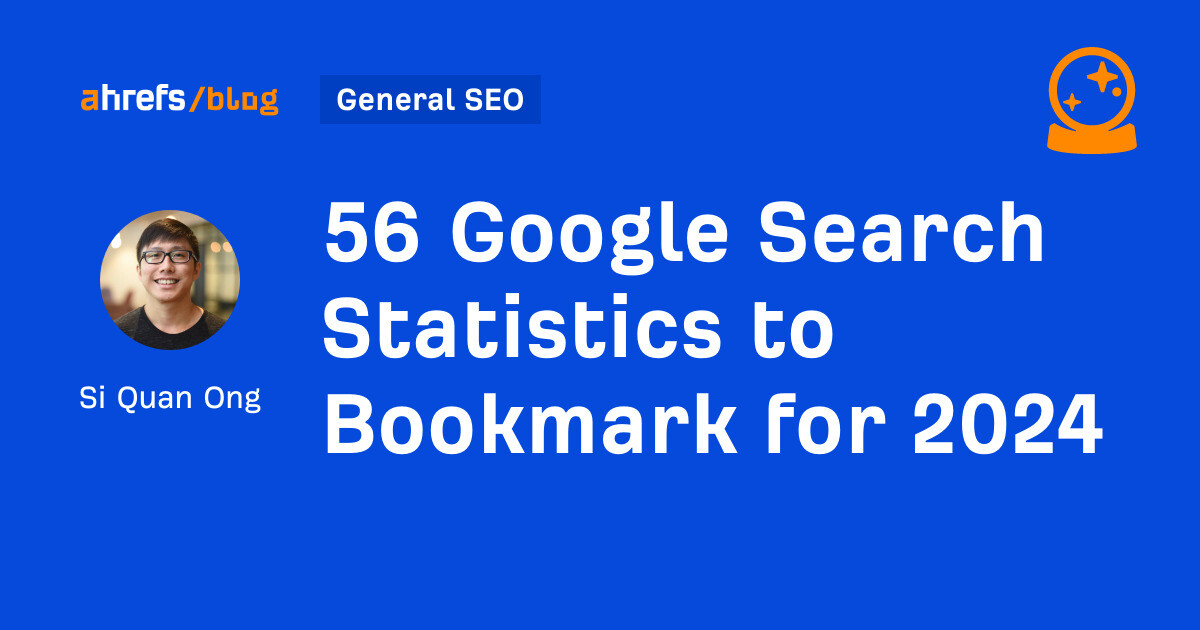
If you’re curious about the state of Google search in 2024, look no further.
Each year we pick, vet, and categorize a list of up-to-date statistics to give you insights from trusted sources on Google search trends.
Check out more resources on how Google works:
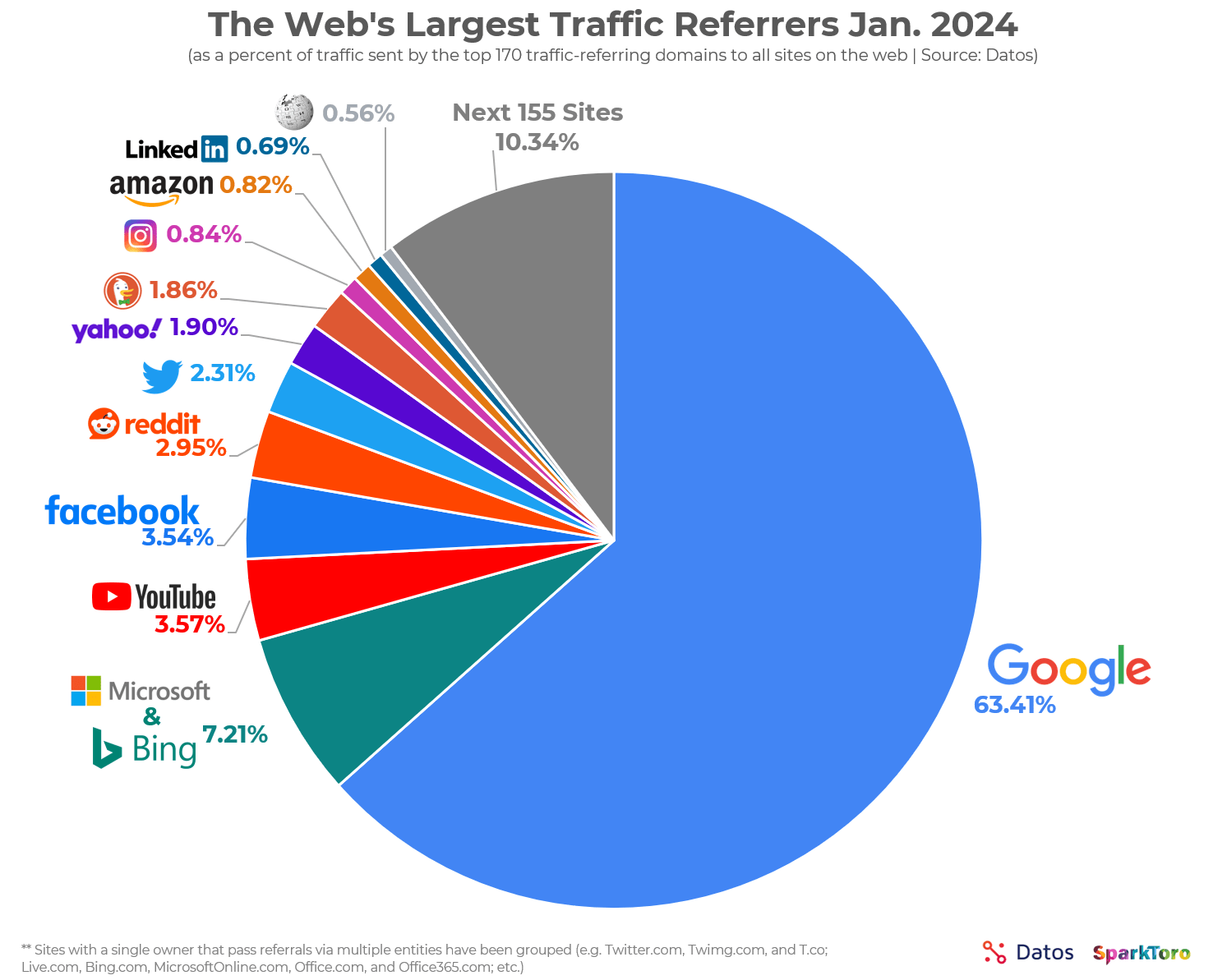

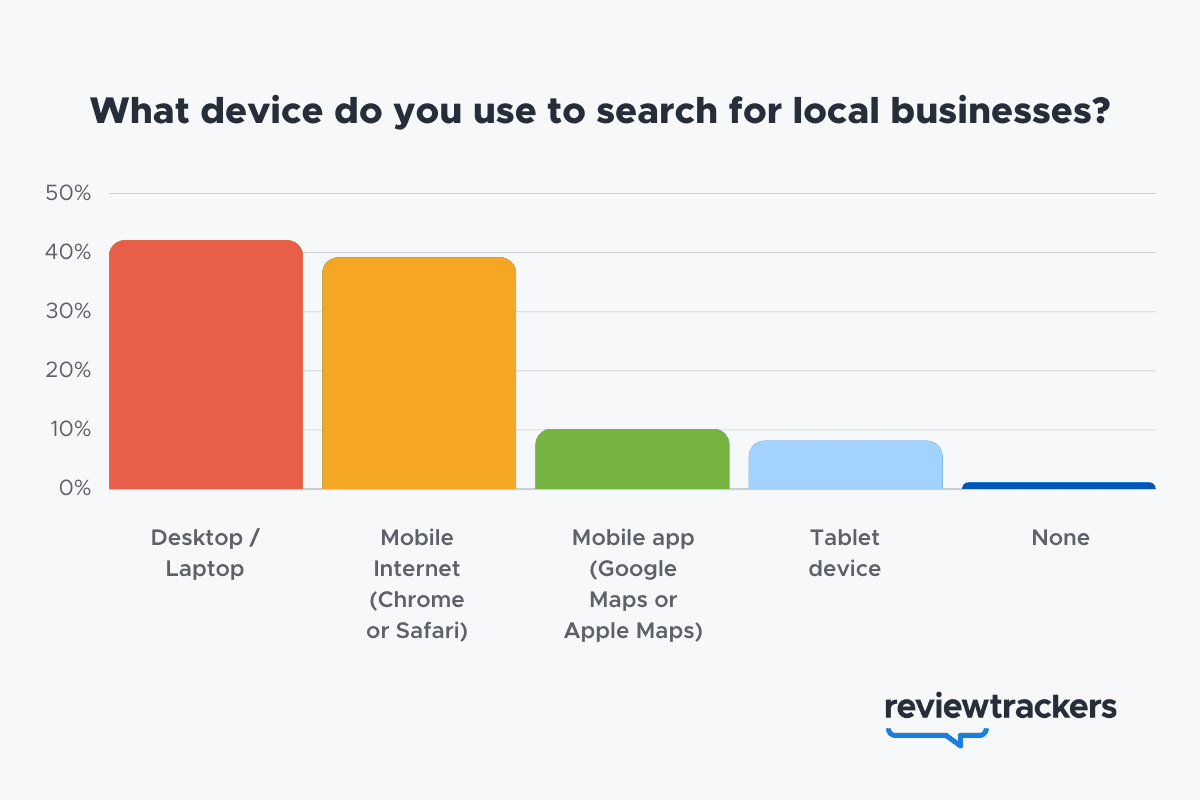

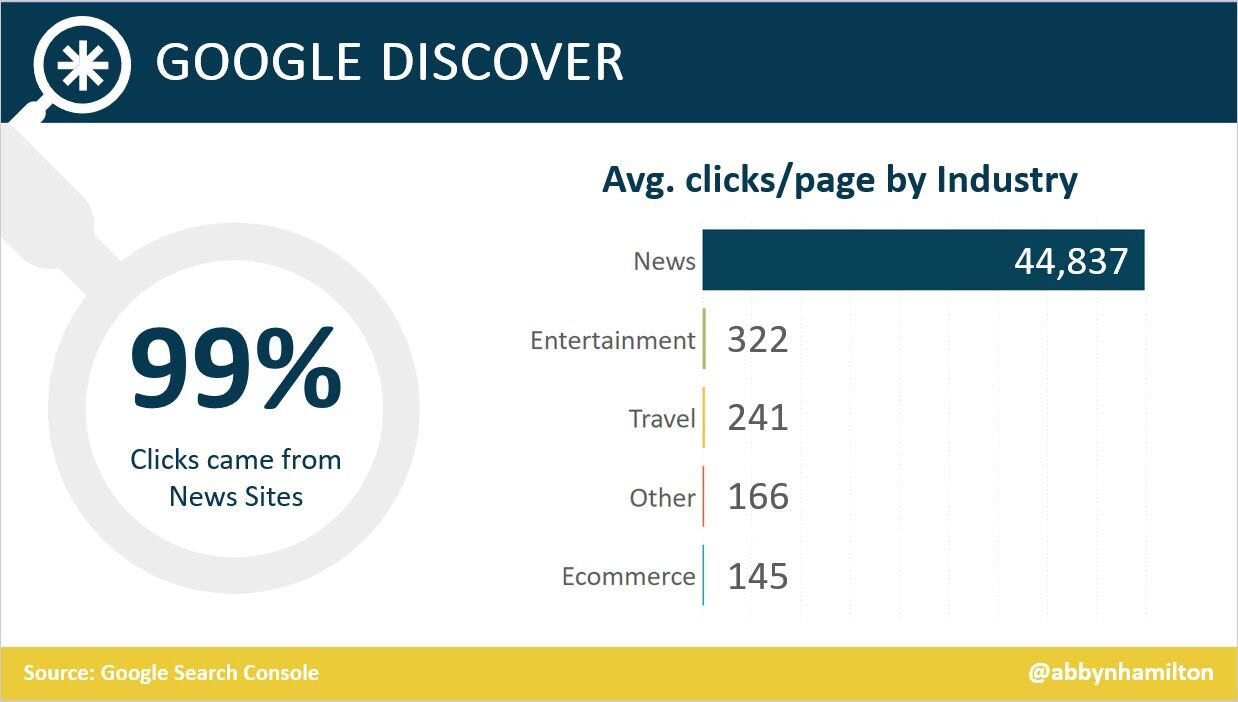

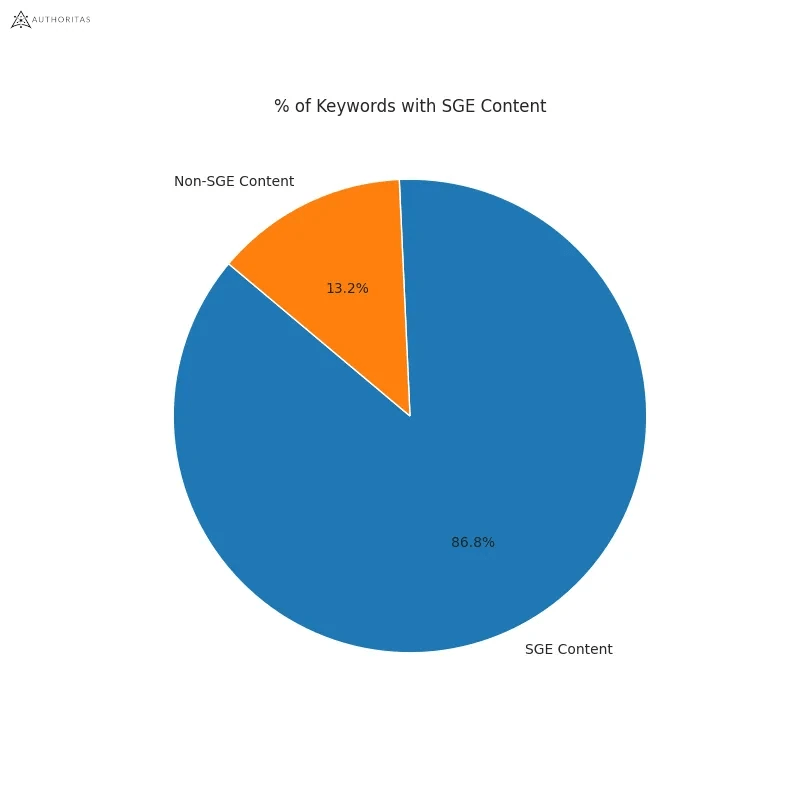

Learn more
SEO
How To Use ChatGPT For Keyword Research

Anyone not using ChatGPT for keyword research is missing a trick.
You can save time and understand an entire topic in seconds instead of hours.
In this article, I outline my most effective ChatGPT prompts for keyword research and teach you how I put them together so that you, too, can take, edit, and enhance them even further.
But before we jump into the prompts, I want to emphasize that you shouldn’t replace keyword research tools or disregard traditional keyword research methods.
ChatGPT can make mistakes. It can even create new keywords if you give it the right prompt. For example, I asked it to provide me with a unique keyword for the topic “SEO” that had never been searched before.
“Interstellar Internet SEO: Optimizing content for the theoretical concept of an interstellar internet, considering the challenges of space-time and interplanetary communication delays.”
Although I want to jump into my LinkedIn profile and update my title to “Interstellar Internet SEO Consultant,” unfortunately, no one has searched that (and they probably never will)!
You must not blindly rely on the data you get back from ChatGPT.
What you can rely on ChatGPT for is the topic ideation stage of keyword research and inspiration.
ChatGPT is a large language model trained with massive amounts of data to accurately predict what word will come next in a sentence. However, it does not know how to do keyword research yet.
Instead, think of ChatGPT as having an expert on any topic armed with the information if you ask it the right question.
In this guide, that is exactly what I aim to teach you how to do – the most essential prompts you need to know when performing topical keyword research.
Best ChatGPT Keyword Research Prompts
The following ChatGPT keyword research prompts can be used on any niche, even a topic to which you are brand new.
For this demonstration, let’s use the topic of “SEO” to demonstrate these prompts.
Generating Keyword Ideas Based On A Topic
What Are The {X} Most Popular Sub-topics Related To {Topic}?
The first prompt is to give you an idea of the niche.
As shown above, ChatGPT did a great job understanding and breaking down SEO into three pillars: on-page, off-page & technical.
The key to the following prompt is to take one of the topics ChatGPT has given and query the sub-topics.
What Are The {X} Most Popular Sub-topics Related To {Sub-topic}?
For this example, let’s query, “What are the most popular sub-topics related to keyword research?”
Having done keyword research for over 10 years, I would expect it to output information related to keyword research metrics, the types of keywords, and intent.
Let’s see.
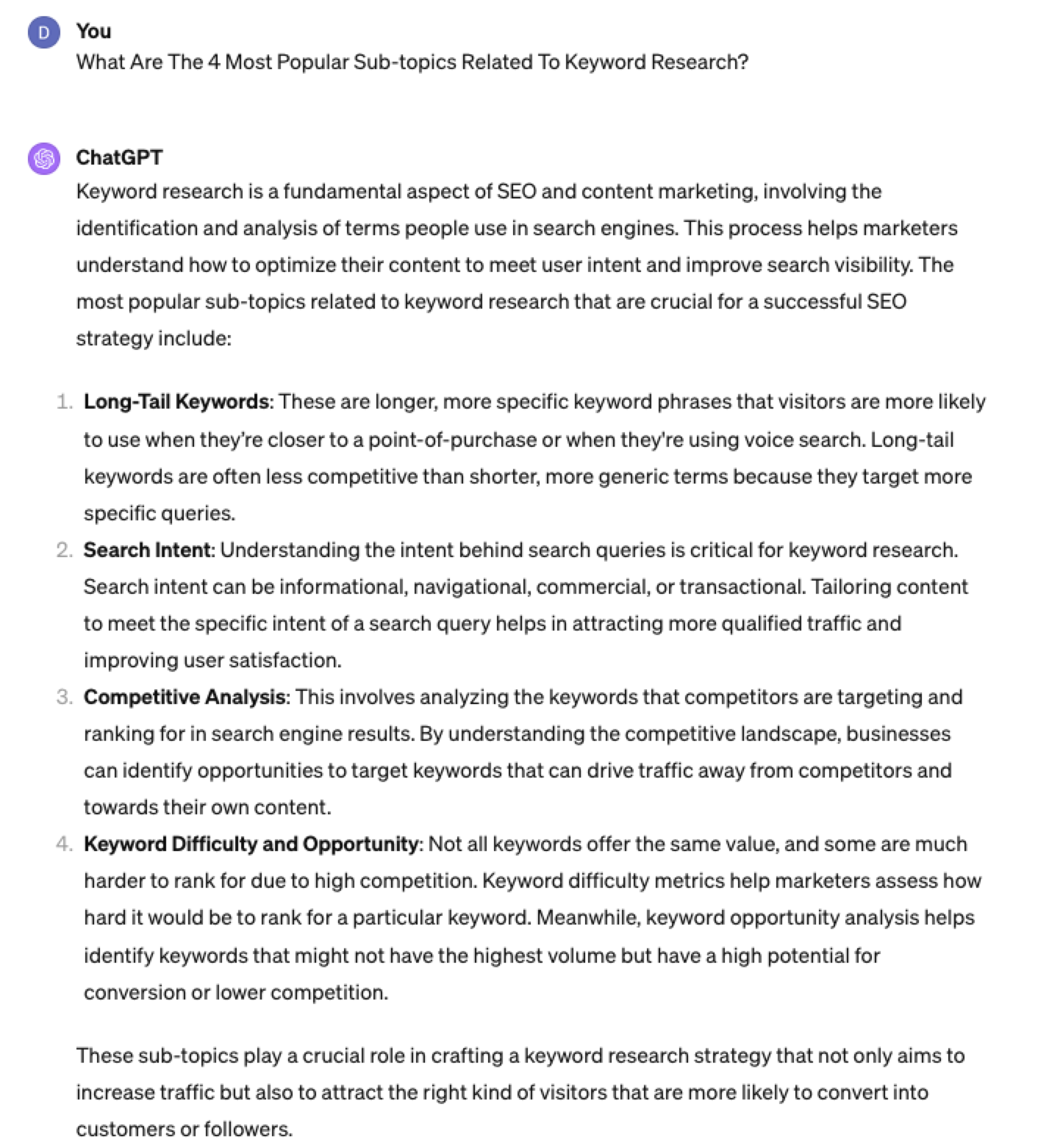 Screenshot from ChatGPT 4, April 2024
Screenshot from ChatGPT 4, April 2024Again, right on the money.
To get the keywords you want without having ChatGPT describe each answer, use the prompt “list without description.”
Here is an example of that.
List Without Description The Top {X} Most Popular Keywords For The Topic Of {X}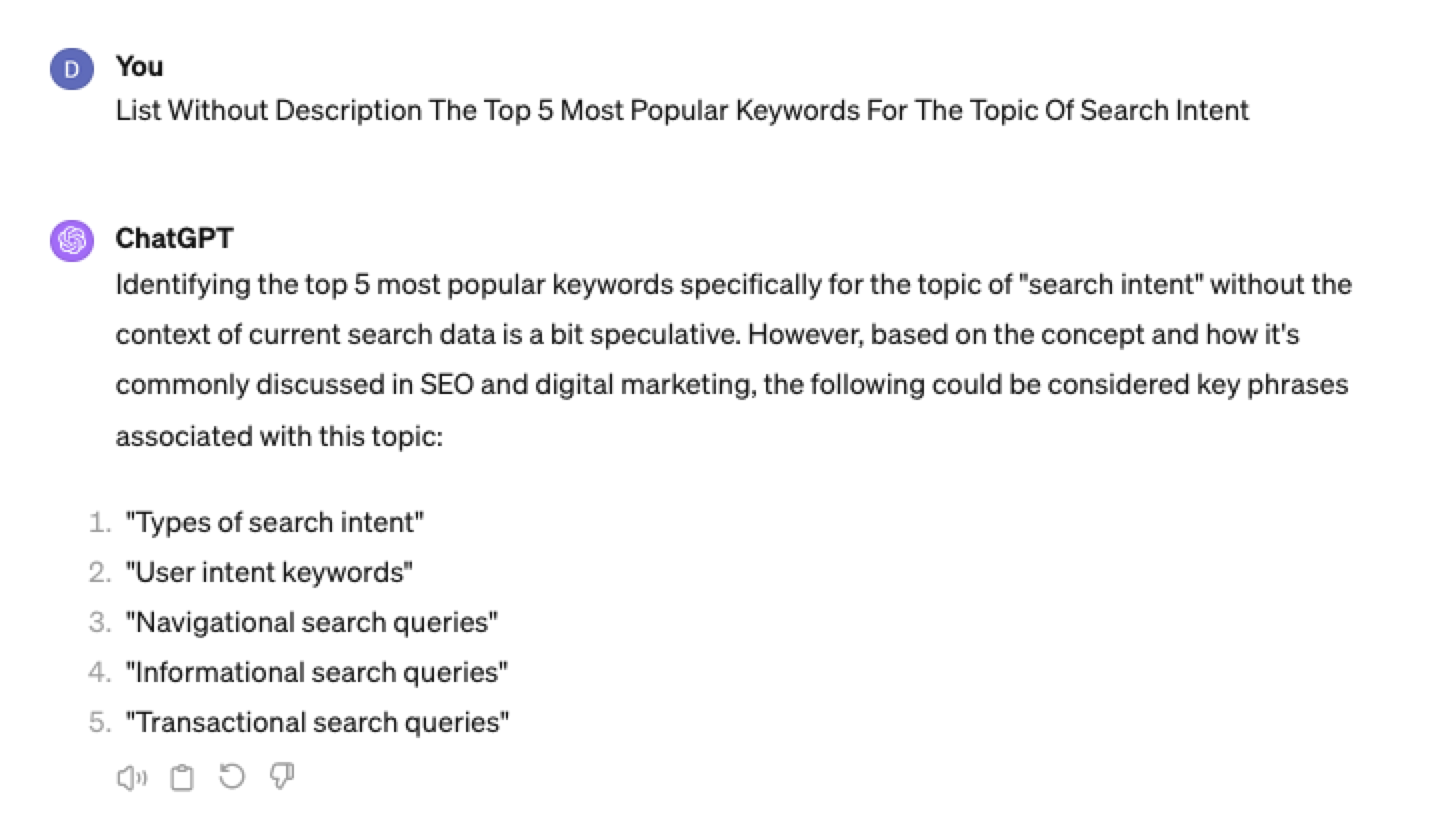
You can even branch these keywords out further into their long-tail.
Example prompt:
List Without Description The Top {X} Most Popular Long-tail Keywords For The Topic “{X}”
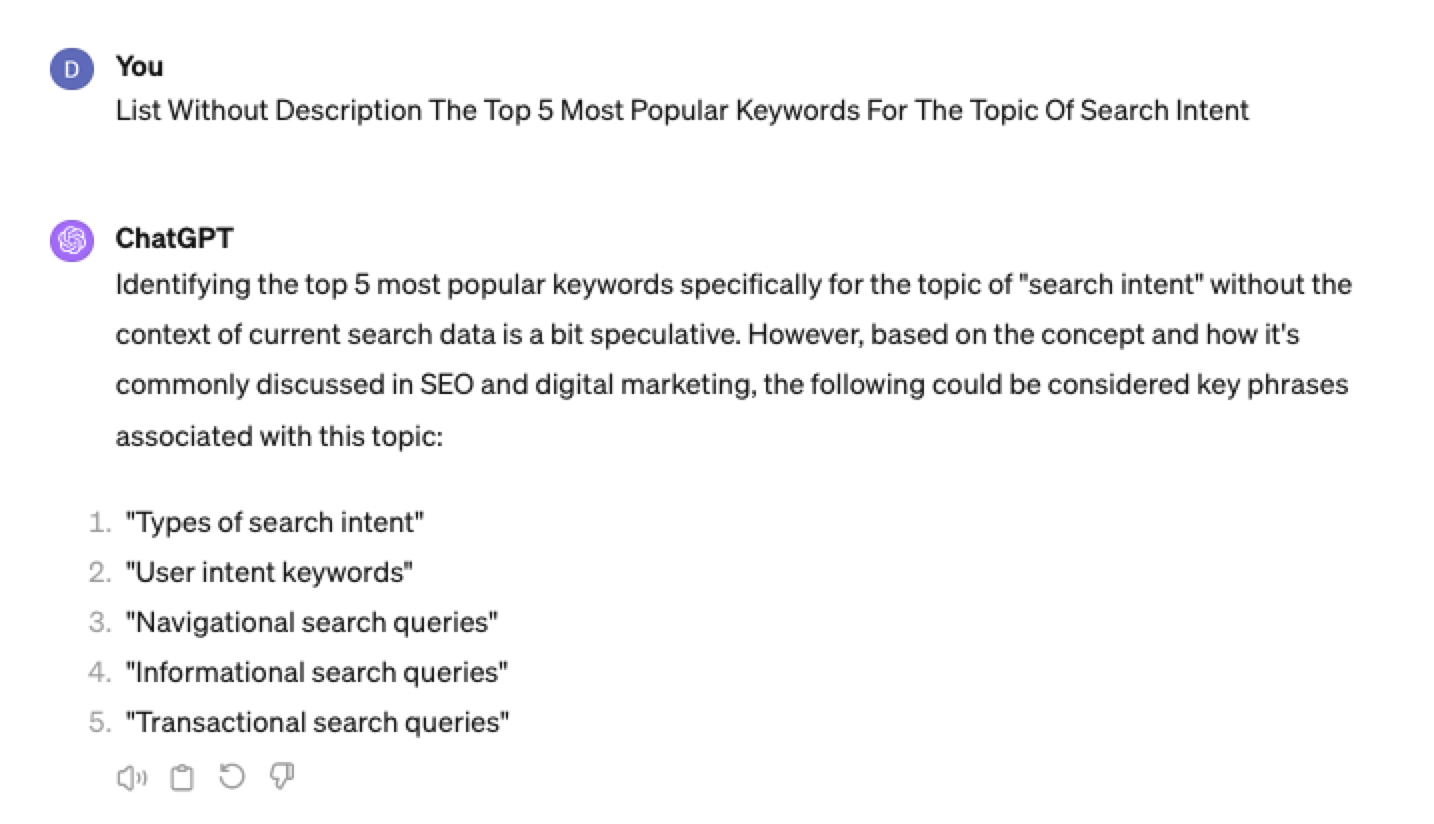 Screenshot ChatGPT 4,April 2024
Screenshot ChatGPT 4,April 2024List Without Description The Top Semantically Related Keywords And Entities For The Topic {X}
You can even ask ChatGPT what any topic’s semantically related keywords and entities are!
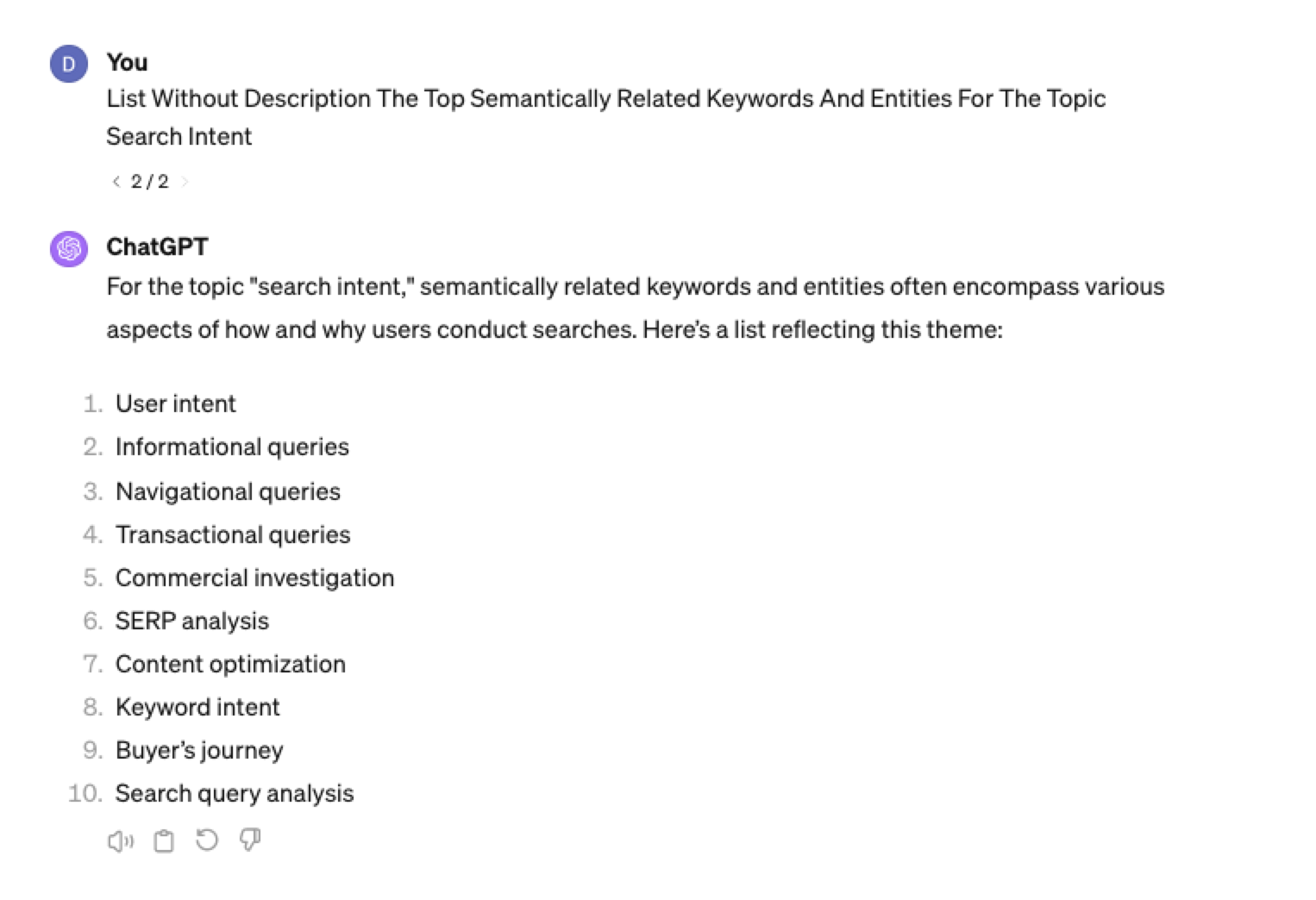 Screenshot ChatGPT 4, April 2024
Screenshot ChatGPT 4, April 2024Tip: The Onion Method Of Prompting ChatGPT
When you are happy with a series of prompts, add them all to one prompt. For example, so far in this article, we have asked ChatGPT the following:
- What are the four most popular sub-topics related to SEO?
- What are the four most popular sub-topics related to keyword research
- List without description the top five most popular keywords for “keyword intent”?
- List without description the top five most popular long-tail keywords for the topic “keyword intent types”?
- List without description the top semantically related keywords and entities for the topic “types of keyword intent in SEO.”
Combine all five into one prompt by telling ChatGPT to perform a series of steps. Example:
“Perform the following steps in a consecutive order Step 1, Step 2, Step 3, Step 4, and Step 5”
Example:
“Perform the following steps in a consecutive order Step 1, Step 2, Step 3, Step 4 and Step 5. Step 1 – Generate an answer for the 3 most popular sub-topics related to {Topic}?. Step 2 – Generate 3 of the most popular sub-topics related to each answer. Step 3 – Take those answers and list without description their top 3 most popular keywords. Step 4 – For the answers given of their most popular keywords, provide 3 long-tail keywords. Step 5 – for each long-tail keyword offered in the response, a list without descriptions 3 of their top semantically related keywords and entities.”
Generating Keyword Ideas Based On A Question
Taking the steps approach from above, we can get ChatGPT to help streamline getting keyword ideas based on a question. For example, let’s ask, “What is SEO?”
“Perform the following steps in a consecutive order Step 1, Step 2, Step 3, and Step 4. Step 1 Generate 10 questions about “{Question}”?. Step 2 – Generate 5 more questions about “{Question}” that do not repeat the above. Step 3 – Generate 5 more questions about “{Question}” that do not repeat the above. Step 4 – Based on the above Steps 1,2,3 suggest a final list of questions avoiding duplicates or semantically similar questions.”
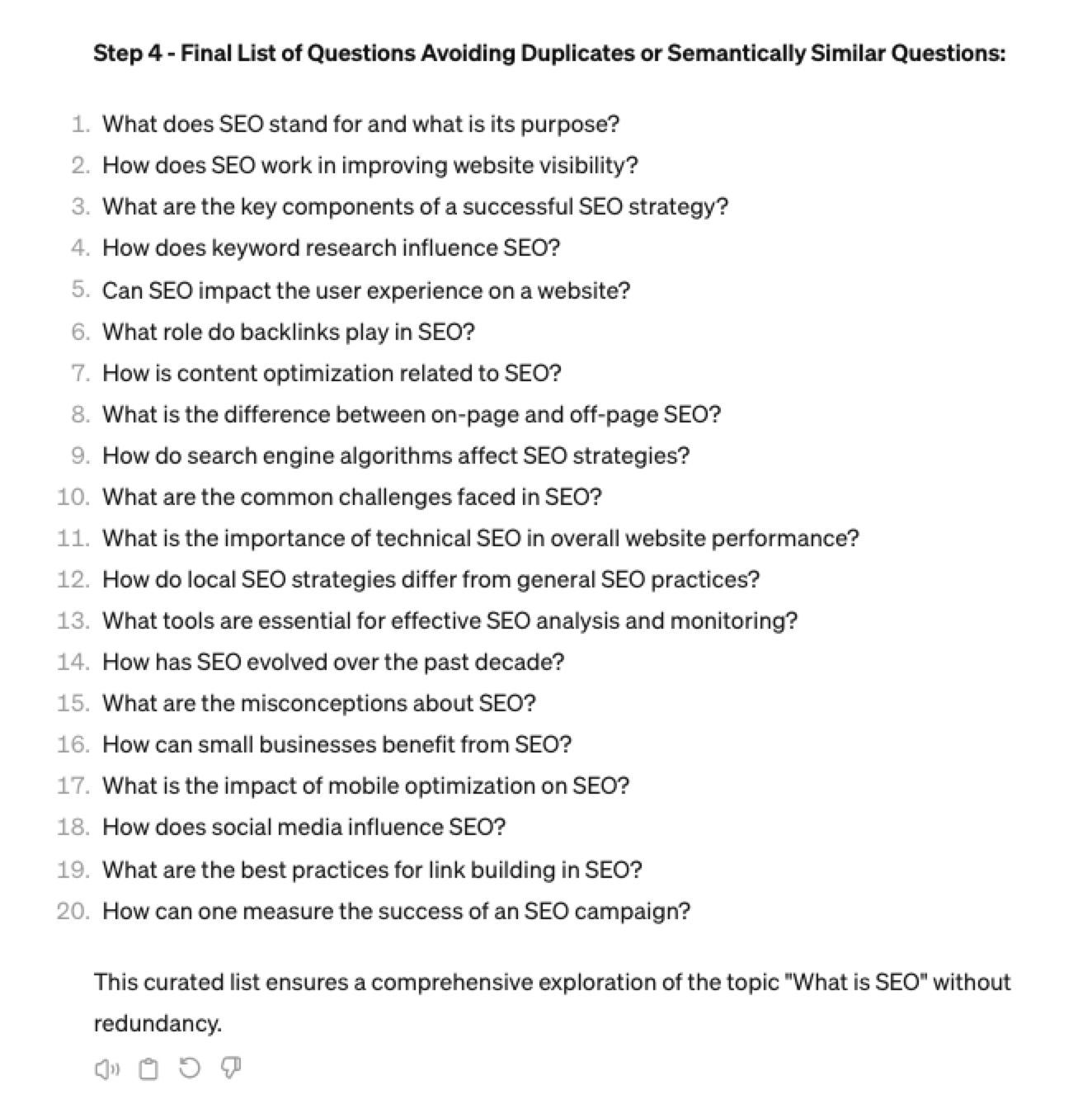 Screenshot ChatGPT 4, April 2024
Screenshot ChatGPT 4, April 2024Generating Keyword Ideas Using ChatGPT Based On The Alphabet Soup Method
One of my favorite methods, manually, without even using a keyword research tool, is to generate keyword research ideas from Google autocomplete, going from A to Z.
-
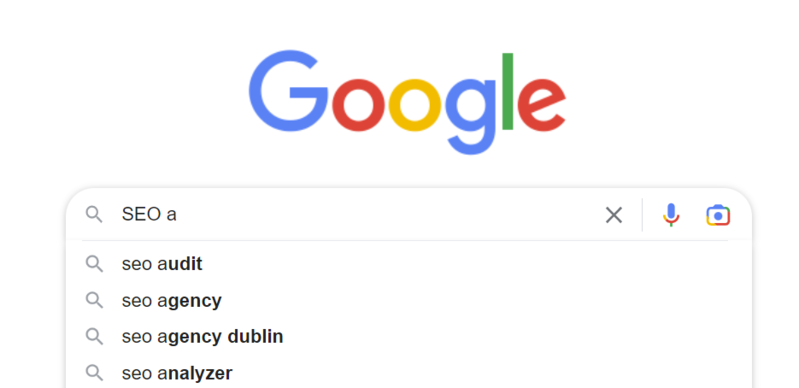 Screenshot from Google autocomplete, April 2024
Screenshot from Google autocomplete, April 2024
You can also do this using ChatGPT.
Example prompt:
“give me popular keywords that includes the keyword “SEO”, and the next letter of the word starts with a”
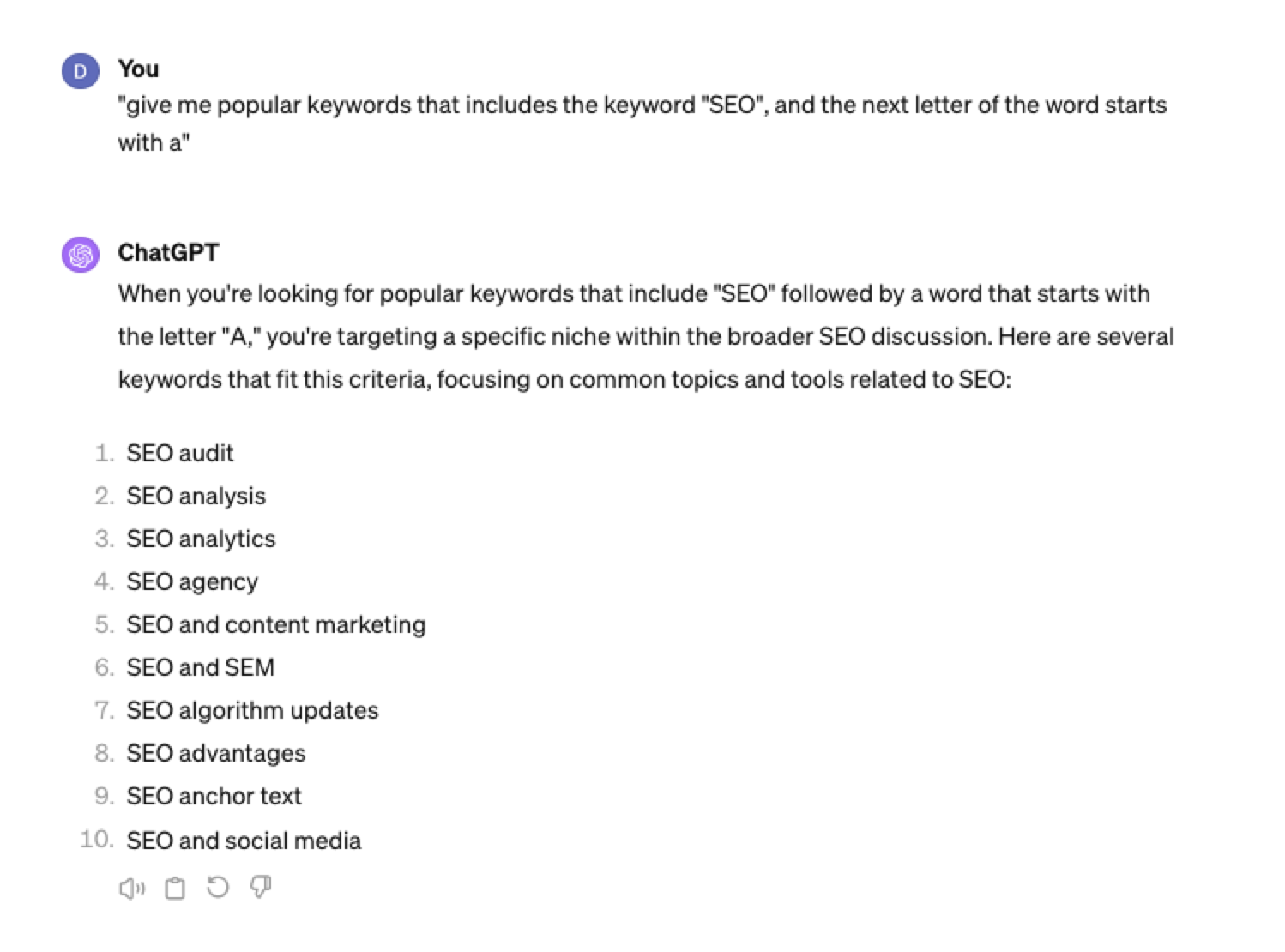 Screenshot from ChatGPT 4, April 2024
Screenshot from ChatGPT 4, April 2024Tip: Using the onion prompting method above, we can combine all this in one prompt.
“Give me five popular keywords that include “SEO” in the word, and the following letter starts with a. Once the answer has been done, move on to giving five more popular keywords that include “SEO” for each letter of the alphabet b to z.”
Generating Keyword Ideas Based On User Personas
When it comes to keyword research, understanding user personas is essential for understanding your target audience and keeping your keyword research focused and targeted. ChatGPT may help you get an initial understanding of customer personas.
Example prompt:
“For the topic of “{Topic}” list 10 keywords each for the different types of user personas”
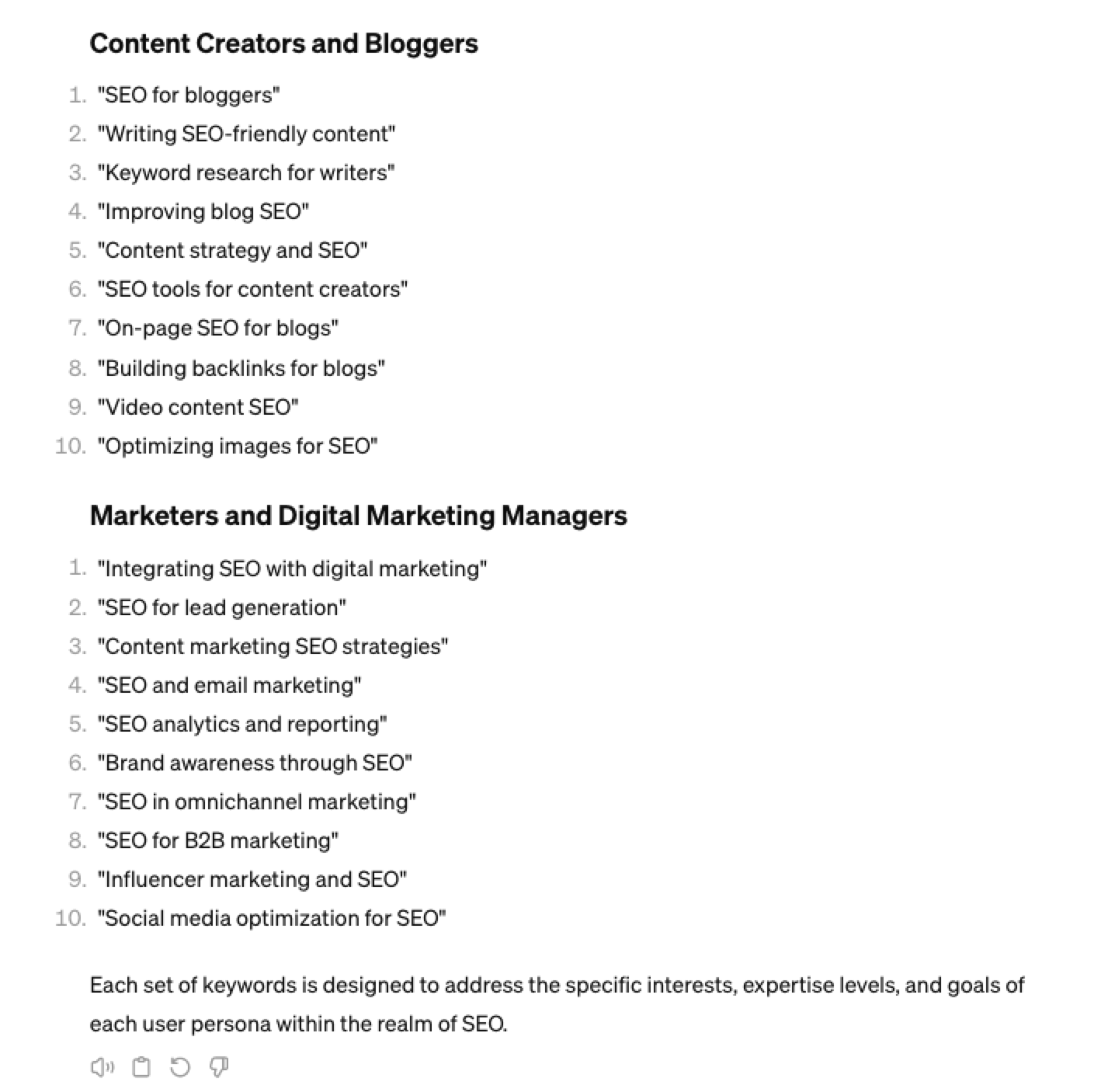 Screenshot from ChatGPT 4, April 2024
Screenshot from ChatGPT 4, April 2024You could even go a step further and ask for questions based on those topics that those specific user personas may be searching for:
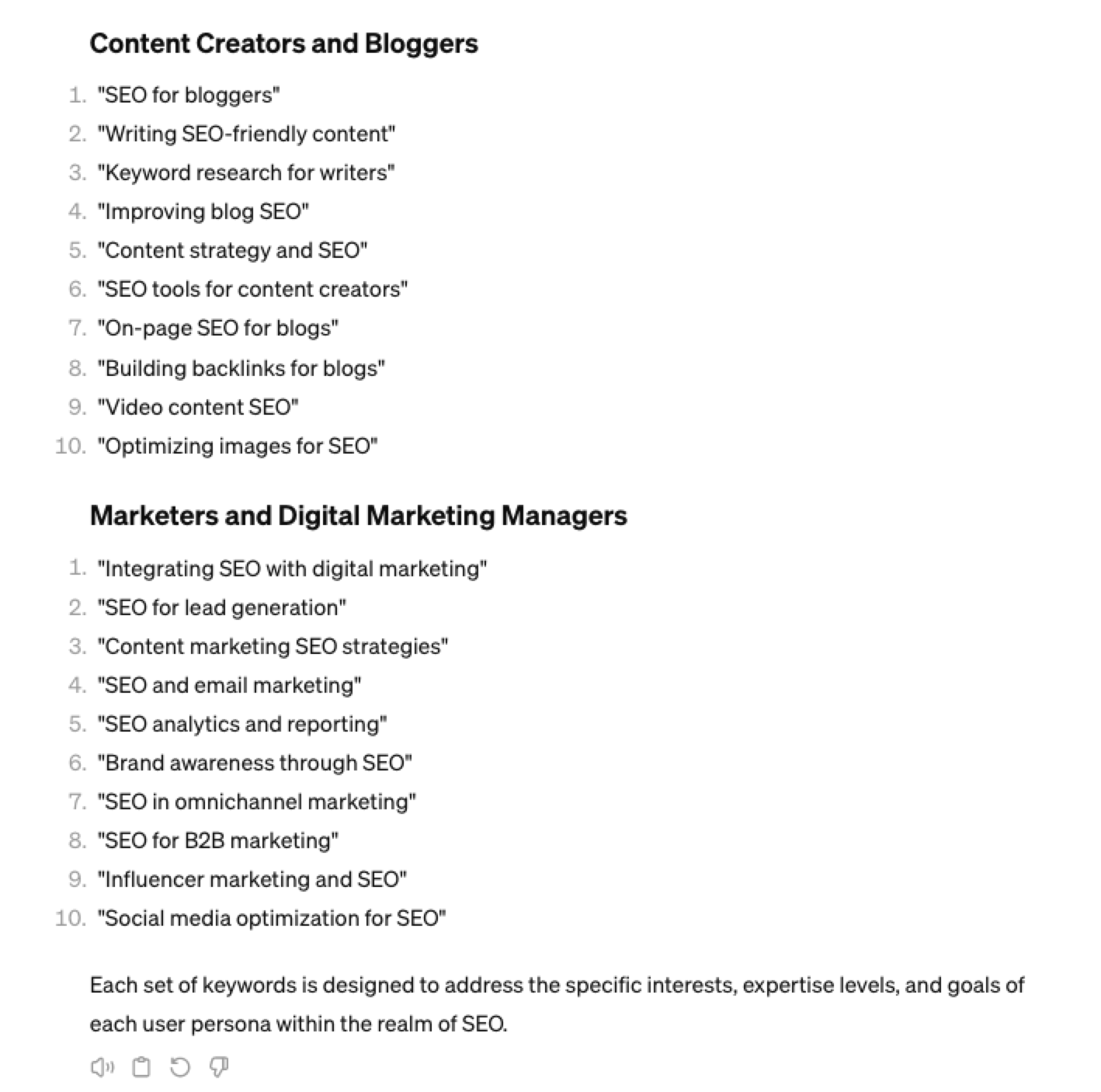 Screenshot ChatGPT 4, April 2024
Screenshot ChatGPT 4, April 2024As well as get the keywords to target based on those questions:
“For each question listed above for each persona, list the keywords, as well as the long-tail keywords to target, and put them in a table”
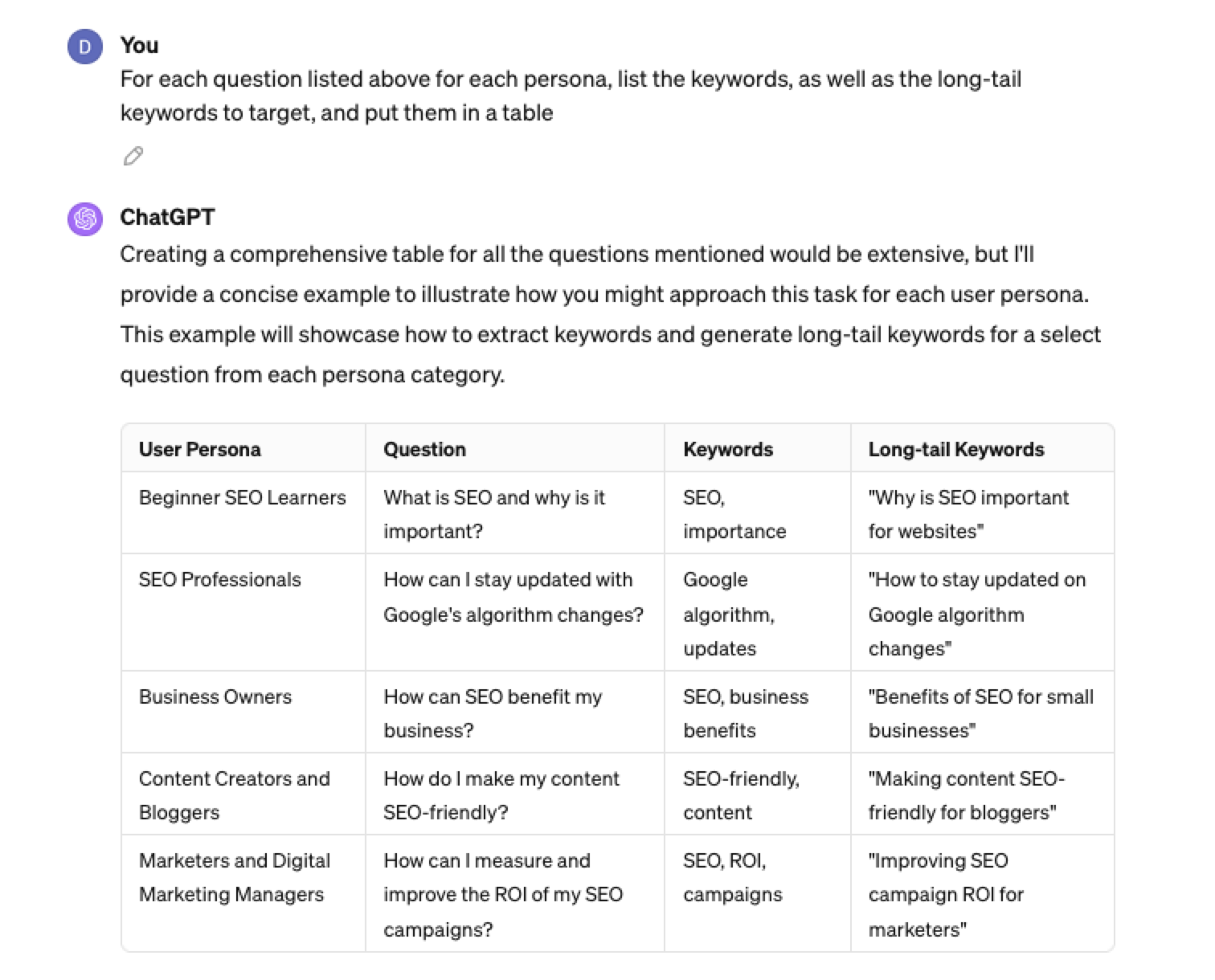 Screenshot from ChatGPT 4, April 2024
Screenshot from ChatGPT 4, April 2024Generating Keyword Ideas Using ChatGPT Based On Searcher Intent And User Personas
Understanding the keywords your target persona may be searching is the first step to effective keyword research. The next step is to understand the search intent behind those keywords and which content format may work best.
For example, a business owner who is new to SEO or has just heard about it may be searching for “what is SEO.”
However, if they are further down the funnel and in the navigational stage, they may search for “top SEO firms.”
You can query ChatGPT to inspire you here based on any topic and your target user persona.
SEO Example:
“For the topic of “{Topic}” list 10 keywords each for the different types of searcher intent that a {Target Persona} would be searching for”
ChatGPT For Keyword Research Admin
Here is how you can best use ChatGPT for keyword research admin tasks.
Using ChatGPT As A Keyword Categorization Tool
One of the use cases for using ChatGPT is for keyword categorization.
In the past, I would have had to devise spreadsheet formulas to categorize keywords or even spend hours filtering and manually categorizing keywords.
ChatGPT can be a great companion for running a short version of this for you.
Let’s say you have done keyword research in a keyword research tool, have a list of keywords, and want to categorize them.
You could use the following prompt:
“Filter the below list of keywords into categories, target persona, searcher intent, search volume and add information to a six-column table: List of keywords – [LIST OF KEYWORDS], Keyword Search Volume [SEARCH VOLUMES] and Keyword Difficulties [KEYWORD DIFFICUTIES].”
-
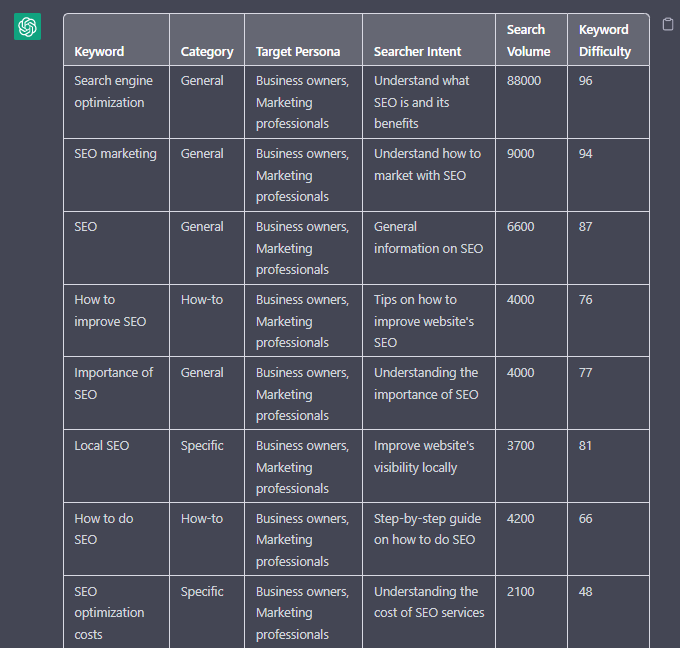 Screenshot from ChatGPT, April 2024
Screenshot from ChatGPT, April 2024
Tip: Add keyword metrics from the keyword research tools, as using the search volumes that a ChatGPT prompt may give you will be wildly inaccurate at best.
Using ChatGPT For Keyword Clustering
Another of ChatGPT’s use cases for keyword research is to help you cluster. Many keywords have the same intent, and by grouping related keywords, you may find that one piece of content can often target multiple keywords at once.
However, be careful not to rely only on LLM data for clustering. What ChatGPT may cluster as a similar keyword, the SERP or the user may not agree with. But it is a good starting point.
The big downside of using ChatGPT for keyword clustering is actually the amount of keyword data you can cluster based on the memory limits.
So, you may find a keyword clustering tool or script that is better for large keyword clustering tasks. But for small amounts of keywords, ChatGPT is actually quite good.
A great use small keyword clustering use case using ChatGPT is for grouping People Also Ask (PAA) questions.
Use the following prompt to group keywords based on their semantic relationships. For example:
“Organize the following keywords into groups based on their semantic relationships, and give a short name to each group: [LIST OF PAA], create a two-column table where each keyword sits on its own row.
-
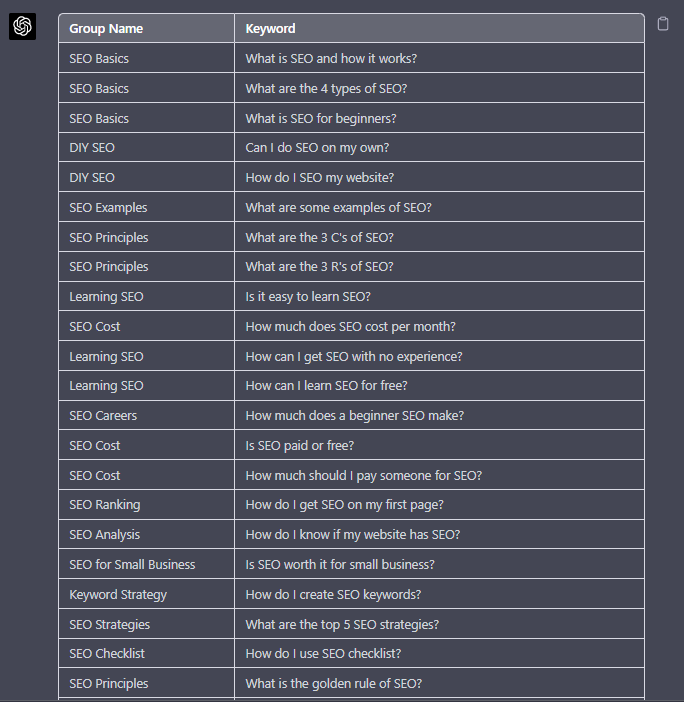 Screenshot from ChatGPT, April 2024
Screenshot from ChatGPT, April 2024
Using Chat GPT For Keyword Expansion By Patterns
One of my favorite methods of doing keyword research is pattern spotting.
Most seed keywords have a variable that can expand your target keywords.
Here are a few examples of patterns:
1. Question Patterns
(who, what, where, why, how, are, can, do, does, will)
“Generate [X] keywords for the topic “[Topic]” that contain any or all of the following “who, what, where, why, how, are, can, do, does, will”
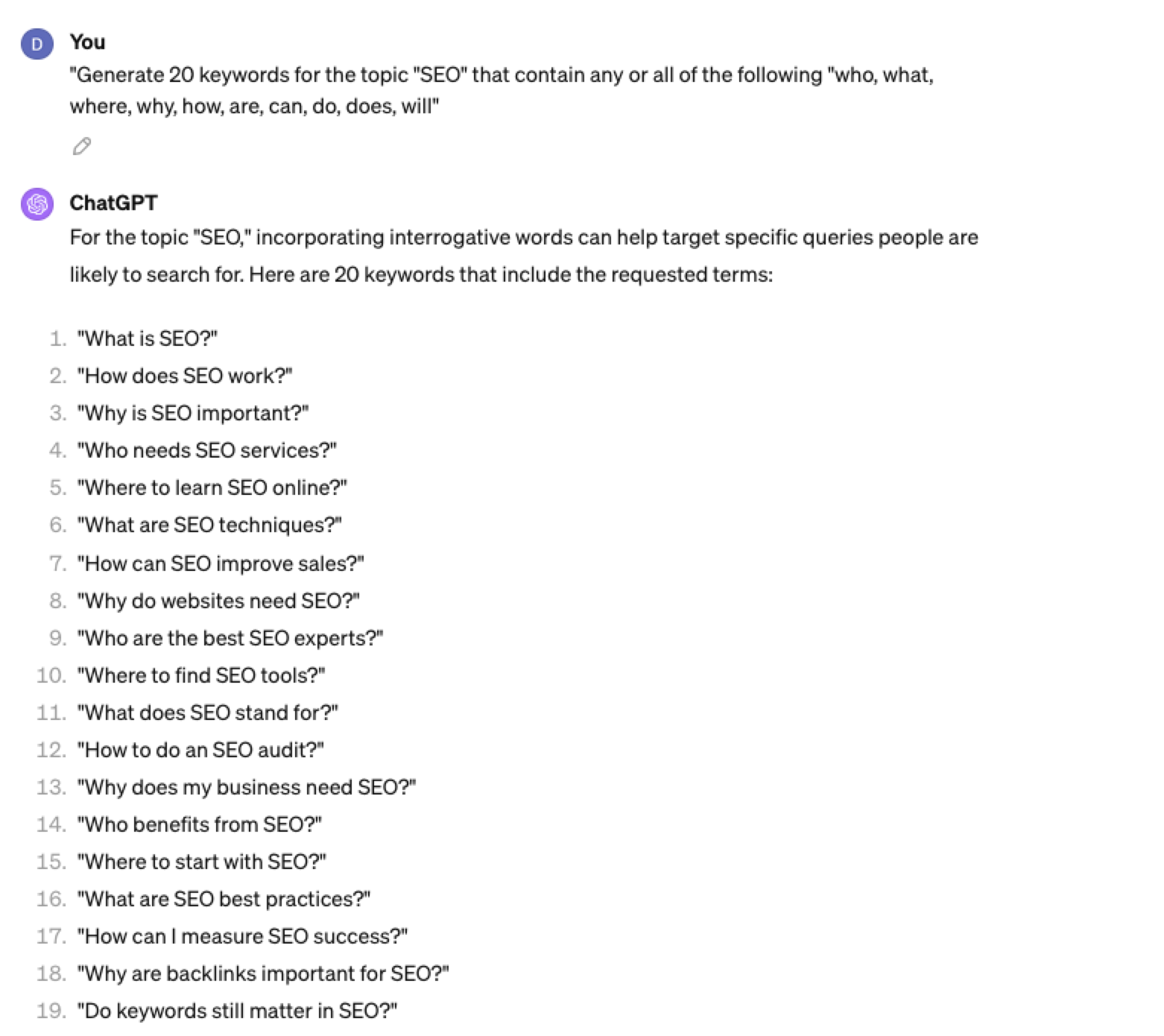 Screenshot ChatGPT 4, April 2024
Screenshot ChatGPT 4, April 20242. Comparison Patterns
Example:
“Generate 50 keywords for the topic “{Topic}” that contain any or all of the following “for, vs, alternative, best, top, review”
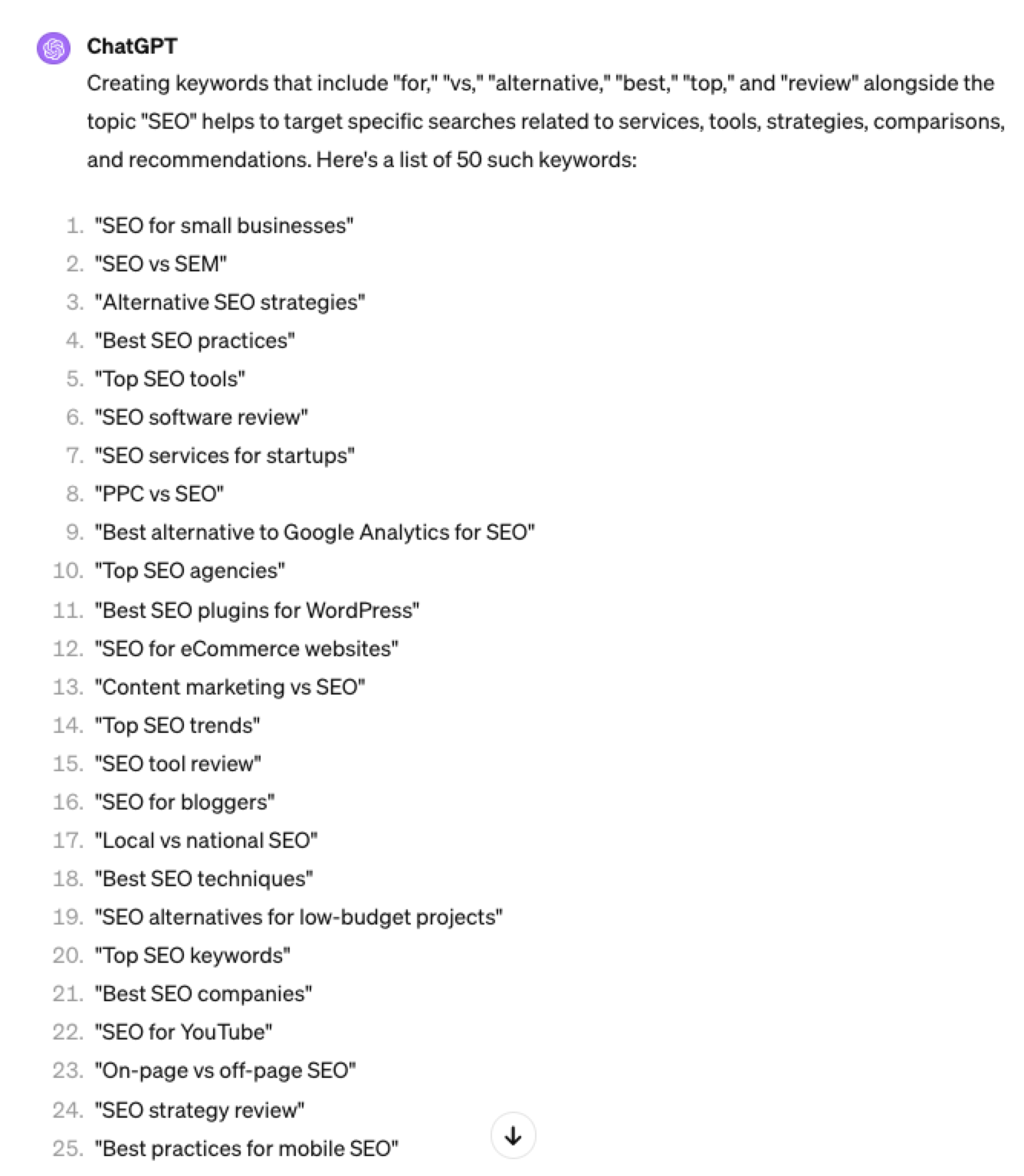 Screenshot ChatGPT 4, April 2024
Screenshot ChatGPT 4, April 20243. Brand Patterns
Another one of my favorite modifiers is a keyword by brand.
We are probably all familiar with the most popular SEO brands; however, if you aren’t, you could ask your AI friend to do the heavy lifting.
Example prompt:
“For the top {Topic} brands what are the top “vs” keywords”
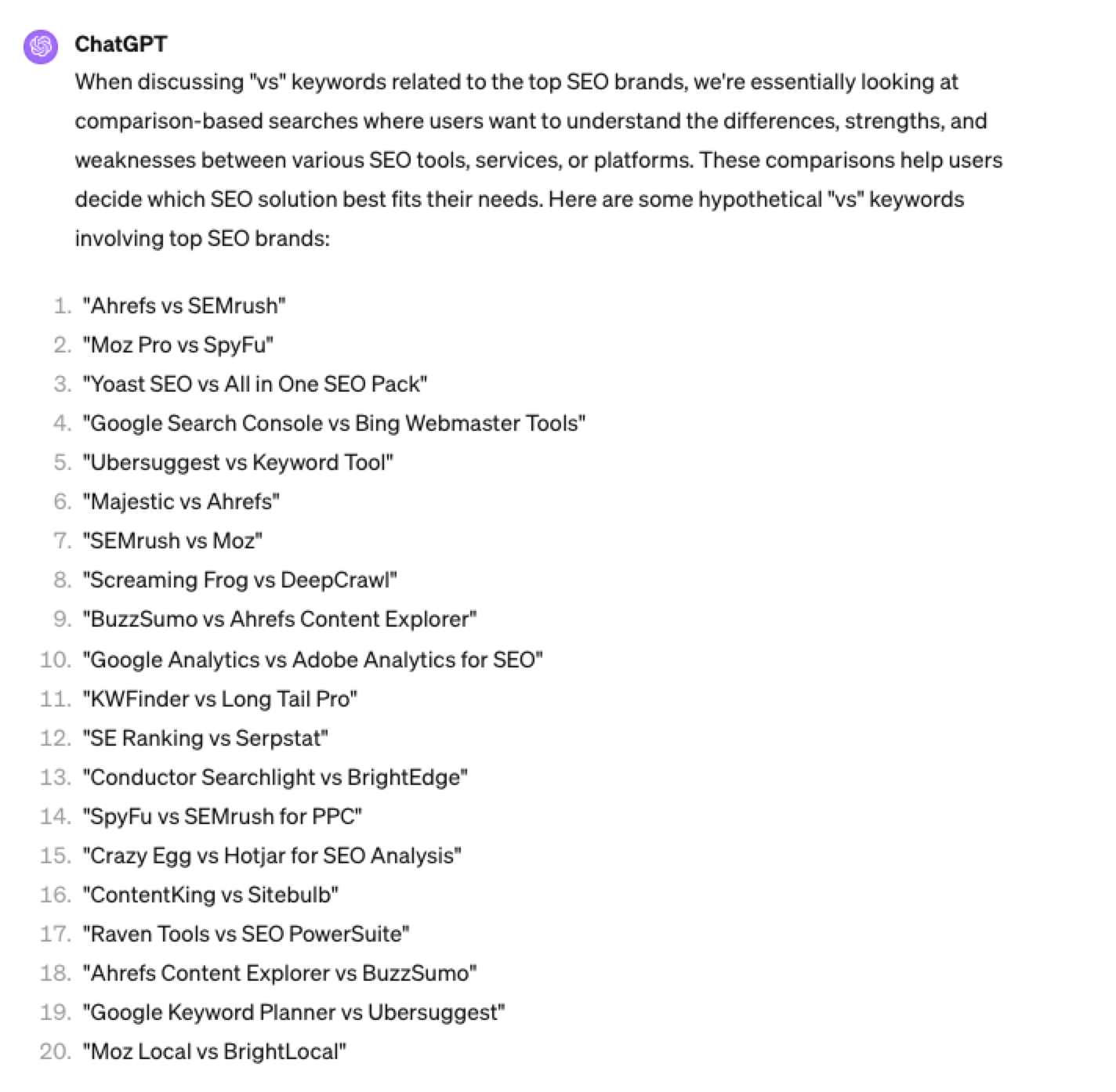 Screenshot ChatGPT 4, April 2024
Screenshot ChatGPT 4, April 20244. Search Intent Patterns
One of the most common search intent patterns is “best.”
When someone is searching for a “best {topic}” keyword, they are generally searching for a comprehensive list or guide that highlights the top options, products, or services within that specific topic, along with their features, benefits, and potential drawbacks, to make an informed decision.
Example:
“For the topic of “[Topic]” what are the 20 top keywords that include “best”
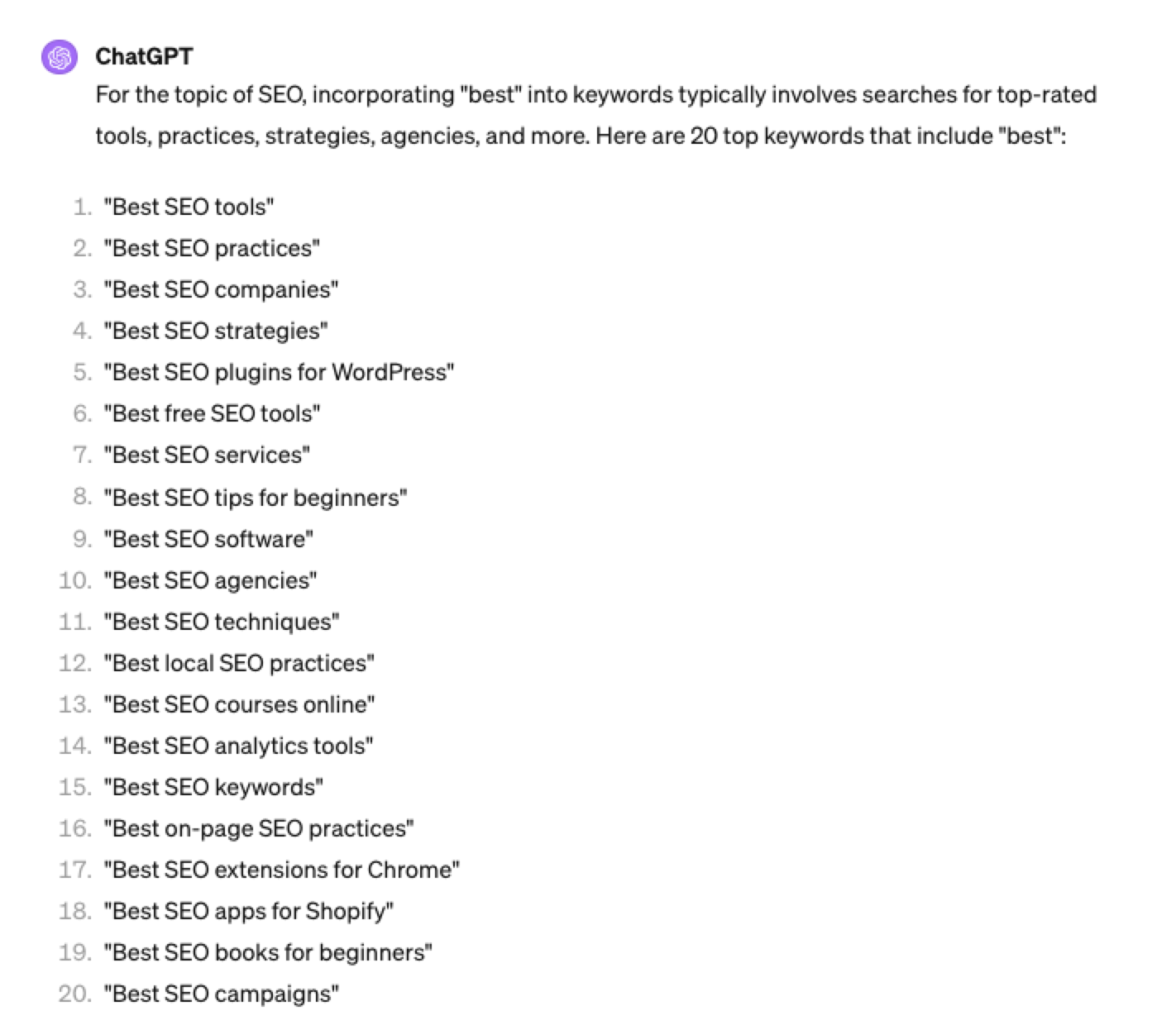 Screenshot ChatGPT 4, April 2024
Screenshot ChatGPT 4, April 2024Again, this guide to keyword research using ChatGPT has emphasized the ease of generating keyword research ideas by utilizing ChatGPT throughout the process.
Keyword Research Using ChatGPT Vs. Keyword Research Tools
Free Vs. Paid Keyword Research Tools
Like keyword research tools, ChatGPT has free and paid options.
However, one of the most significant drawbacks of using ChatGPT for keyword research alone is the absence of SEO metrics to help you make smarter decisions.
To improve accuracy, you could take the results it gives you and verify them with your classic keyword research tool – or vice versa, as shown above, uploading accurate data into the tool and then prompting.
However, you must consider how long it takes to type and fine-tune your prompt to get your desired data versus using the filters within popular keyword research tools.
For example, if we use a popular keyword research tool using filters, you could have all of the “best” queries with all of their SEO metrics:
-
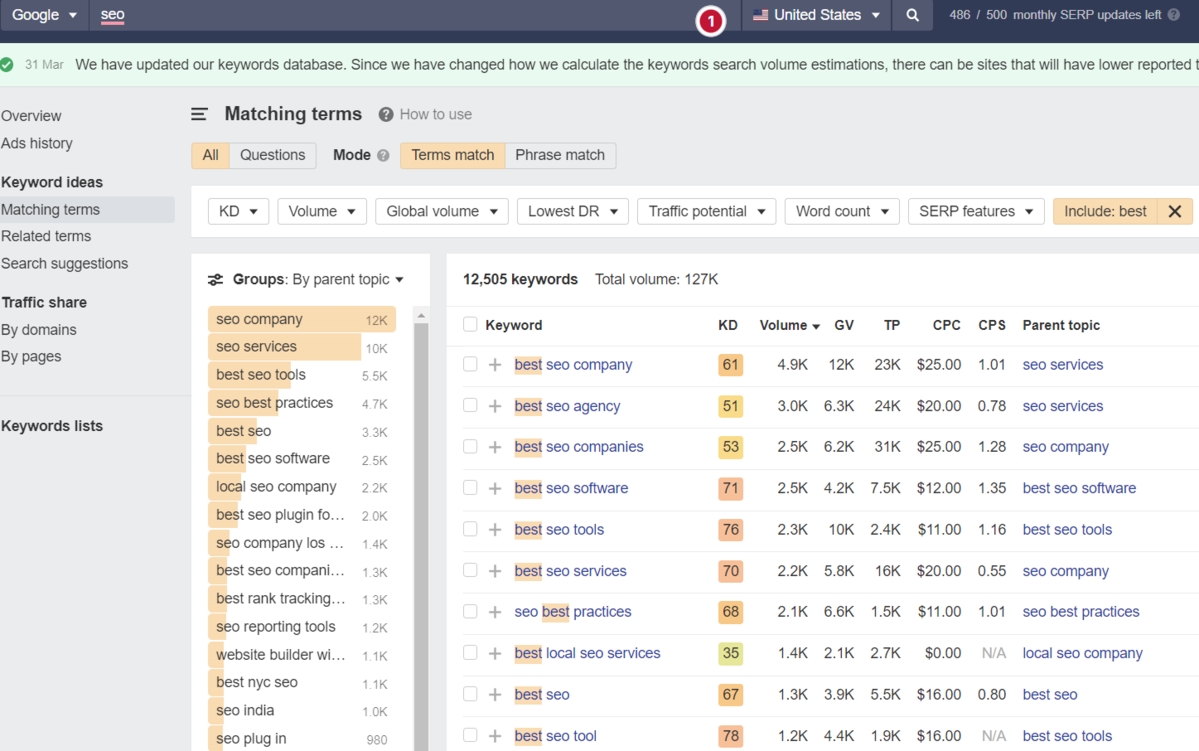 Screenshot from Ahrefs Keyword Explorer, March 2024
Screenshot from Ahrefs Keyword Explorer, March 2024
And unlike ChatGPT, generally, there is no token limit; you can extract several hundred, if not thousands, of keywords at a time.
As I have mentioned multiple times throughout this piece, you cannot blindly trust the data or SEO metrics it may attempt to provide you with.
The key is to validate the keyword research with a keyword research tool.
ChatGPT For International SEO Keyword Research
ChatGPT can be a terrific multilingual keyword research assistant.
For example, if you wanted to research keywords in a foreign language such as French. You could ask ChatGPT to translate your English keywords;
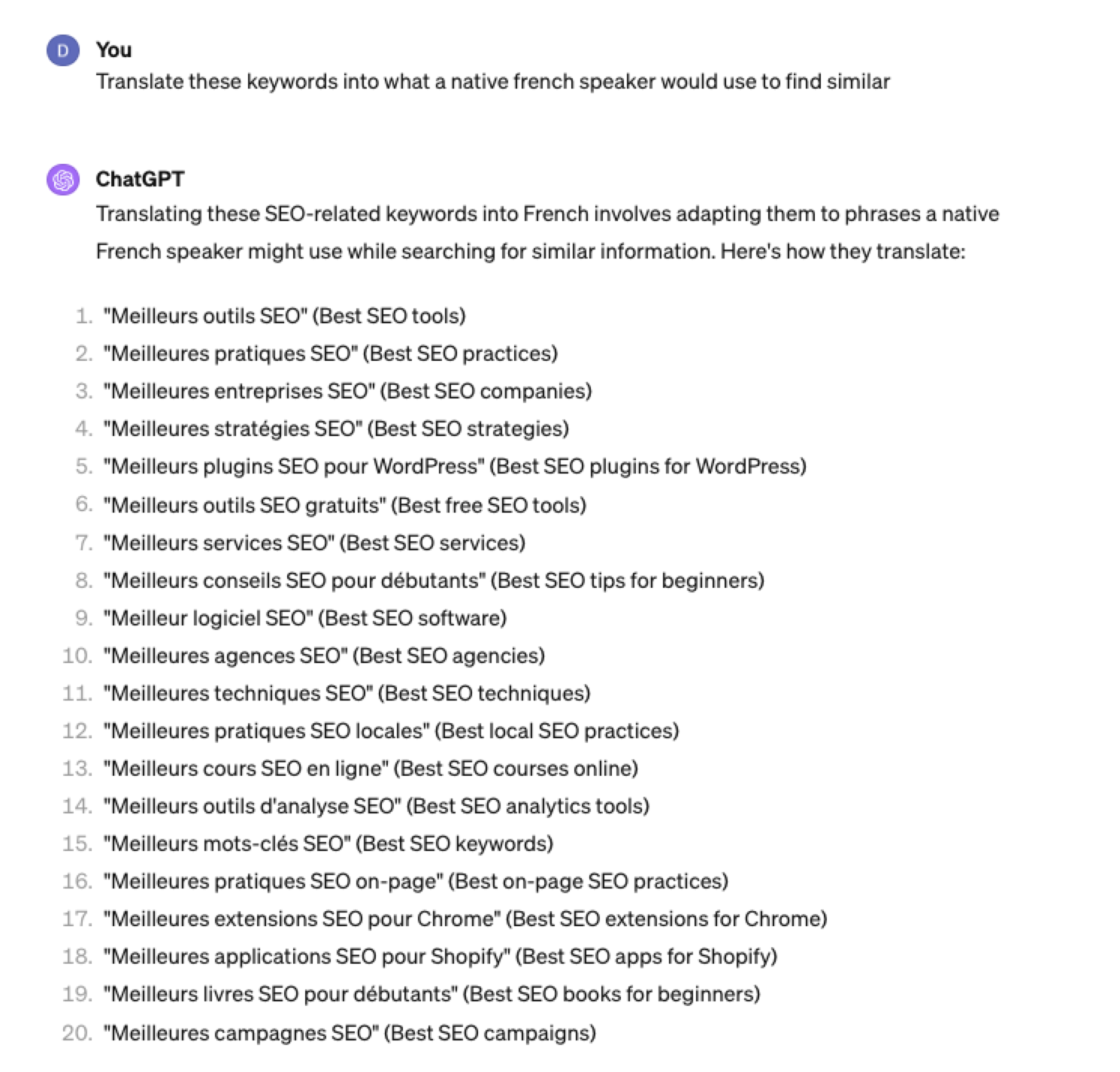 Screenshot ChatGPT 4, Apil 2024
Screenshot ChatGPT 4, Apil 2024- The key is to take the data above and paste it into a popular keyword research tool to verify.
- As you can see below, many of the keyword translations for the English keywords do not have any search volume for direct translations in French.
 Screenshot from Ahrefs Keyword Explorer, April 2024
Screenshot from Ahrefs Keyword Explorer, April 2024But don’t worry, there is a workaround: If you have access to a competitor keyword research tool, you can see what webpage is ranking for that query – and then identify the top keyword for that page based on the ChatGPT translated keywords that do have search volume.
-
-
 Screenshot from Ahrefs Keyword Explorer, April 2024
Screenshot from Ahrefs Keyword Explorer, April 2024
Or, if you don’t have access to a paid keyword research tool, you could always take the top-performing result, extract the page copy, and then ask ChatGPT what the primary keyword for the page is.
Key Takeaway
-
ChatGPT can be an expert on any topic and an invaluable keyword research tool. However, it is another tool to add to your toolbox when doing keyword research; it does not replace traditional keyword research tools.
As shown throughout this tutorial, from making up keywords at the beginning to inaccuracies around data and translations, ChatGPT can make mistakes when used for keyword research.
You cannot blindly trust the data you get back from ChatGPT.
However, it can offer a shortcut to understanding any topic for which you need to do keyword research and, as a result, save you countless hours.
But the key is how you prompt.
The prompts I shared with you above will help you understand a topic in minutes instead of hours and allow you to better seed keywords using keyword research tools.
It can even replace mundane keyword clustering tasks that you used to do with formulas in spreadsheets or generate ideas based on keywords you give it.
Paired with traditional keyword research tools, ChatGPT for keyword research can be a powerful tool in your arsenal.
More resources:
Featured Image: Tatiana Shepeleva/Shutterstock
SEO
OpenAI Expected to Integrate Real-Time Data In ChatGPT

Sam Altman, CEO of OpenAI, dispelled rumors that a new search engine would be announced on Monday, May 13. Recent deals have raised the expectation that OpenAI will announce the integration of real-time content from English, Spanish, and French publications into ChatGPT, complete with links to the original sources.
OpenAI Search Is Not Happening
Many competing search engines have tried and failed to challenge Google as the leading search engine. A new wave of hybrid generative AI search engines is currently trying to knock Google from the top spot with arguably very little success.
Sam Altman is on record saying that creating a search engine to compete against Google is not a viable approach. He suggested that technological disruption was the way to replace Google by changing the search paradigm altogether. The speculation that Altman is going to announce a me-too search engine on Monday never made sense given his recent history of dismissing the concept as a non-starter.
So perhaps it’s not a surprise that he recently ended the speculation by explicitly saying that he will not be announcing a search engine on Monday.
He tweeted:
“not gpt-5, not a search engine, but we’ve been hard at work on some new stuff we think people will love! feels like magic to me.”
“New Stuff” May Be Iterative Improvement
It’s quite likely that what’s going to be announced is iterative which means it improves ChatGPT but not replaces it. This fits into how Altman recently expressed his approach with ChatGPT.
He remarked:
“And it does kind of suck to ship a product that you’re embarrassed about, but it’s much better than the alternative. And in this case in particular, where I think we really owe it to society to deploy iteratively.
There could totally be things in the future that would change where we think iterative deployment isn’t such a good strategy, but it does feel like the current best approach that we have and I think we’ve gained a lot from from doing this and… hopefully the larger world has gained something too.”
Improving ChatGPT iteratively is Sam Altman’s preference and recent clues point to what those changes may be.
Recent Deals Contain Clues
OpenAI has been making deals with news media and User Generated Content publishers since December 2023. Mainstream media has reported these deals as being about licensing content for training large language models. But they overlooked a a key detail that we reported on last month which is that these deals give OpenAI access to real-time information that they stated will be used to give attribution to that real-time data in the form of links.
That means that ChatGPT users will gain the ability to access real-time news and to use that information creatively within ChatGPT.
Dotdash Meredith Deal
Dotdash Meredith (DDM) is the publisher of big brand publications such as Better Homes & Gardens, FOOD & WINE, InStyle, Investopedia, and People magazine. The deal that was announced goes way beyond using the content as training data. The deal is explicitly about surfacing the Dotdash Meredith content itself in ChatGPT.
The announcement stated:
“As part of the agreement, OpenAI will display content and links attributed to DDM in relevant ChatGPT responses. …This deal is a testament to the great work OpenAI is doing on both fronts to partner with creators and publishers and ensure a healthy Internet for the future.
Over 200 million Americans each month trust our content to help them make decisions, solve problems, find inspiration, and live fuller lives. This partnership delivers the best, most relevant content right to the heart of ChatGPT.”
A statement from OpenAI gives credibility to the speculation that OpenAI intends to directly show licensed third-party content as part of ChatGPT answers.
OpenAI explained:
“We’re thrilled to partner with Dotdash Meredith to bring its trusted brands to ChatGPT and to explore new approaches in advancing the publishing and marketing industries.”
Something that DDM also gets out of this deal is that OpenAI will enhance DDM’s in-house ad targeting in order show more tightly focused contextual advertising.
Le Monde And Prisa Media Deals
In March 2024 OpenAI announced a deal with two global media companies, Le Monde and Prisa Media. Le Monde is a French news publication and Prisa Media is a Spanish language multimedia company. The interesting aspects of these two deals is that it gives OpenAI access to real-time data in French and Spanish.
Prisa Media is a global Spanish language media company based in Madrid, Spain that is comprised of magazines, newspapers, podcasts, radio stations, and television networks. It’s reach extends from Spain to America. American media companies include publications in the United States, Argentina, Bolivia, Chile, Colombia, Costa Rica, Ecuador, Mexico, and Panama. That is a massive amount of real-time information in addition to a massive audience of millions.
OpenAI explicitly announced that the purpose of this deal was to bring this content directly to ChatGPT users.
The announcement explained:
“We are continually making improvements to ChatGPT and are supporting the essential role of the news industry in delivering real-time, authoritative information to users. …Our partnerships will enable ChatGPT users to engage with Le Monde and Prisa Media’s high-quality content on recent events in ChatGPT, and their content will also contribute to the training of our models.”
That deal is not just about training data. It’s about bringing current events data to ChatGPT users.
The announcement elaborated in more detail:
“…our goal is to enable ChatGPT users around the world to connect with the news in new ways that are interactive and insightful.”
As noted in our April 30th article that revealed that OpenAI will show links in ChatGPT, OpenAI intends to show third party content with links to that content.
OpenAI commented on the purpose of the Le Monde and Prisa Media partnership:
“Over the coming months, ChatGPT users will be able to interact with relevant news content from these publishers through select summaries with attribution and enhanced links to the original articles, giving users the ability to access additional information or related articles from their news sites.”
There are additional deals with other groups like The Financial Times which also stress that this deal will result in a new ChatGPT feature that will allow users to interact with real-time news and current events .
OpenAI’s Monday May 13 Announcement
There are many clues that the announcement on Monday will be that ChatGPT users will gain the ability to interact with content about current events. This fits into the terms of recent deals with news media organizations. There may be other features announced as well but this part is something that there are many clues pointing to.
Watch Altman’s interview at Stanford University
Featured Image by Shutterstock/photosince
-

 PPC5 days ago
PPC5 days agoHow the TikTok Algorithm Works in 2024 (+9 Ways to Go Viral)
-

 SEO6 days ago
SEO6 days agoBlog Post Checklist: Check All Prior to Hitting “Publish”
-

 SEO4 days ago
SEO4 days agoHow to Use Keywords for SEO: The Complete Beginner’s Guide
-

 MARKETING5 days ago
MARKETING5 days agoHow To Protect Your People and Brand
-

 PPC7 days ago
PPC7 days agoHow to Craft Compelling Google Ads for eCommerce
-

 SEARCHENGINES6 days ago
SEARCHENGINES6 days agoGoogle Started Enforcing The Site Reputation Abuse Policy
-

 MARKETING6 days ago
MARKETING6 days agoElevating Women in SEO for a More Inclusive Industry
-

 PPC6 days ago
PPC6 days agoHow to Brainstorm Business Ideas: 9 Fool-Proof Approaches


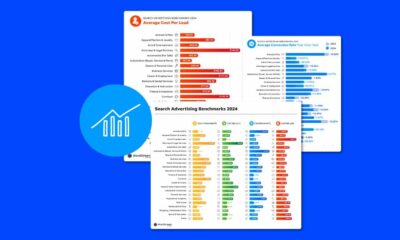

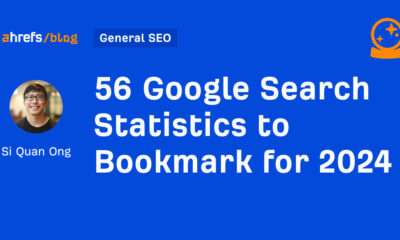







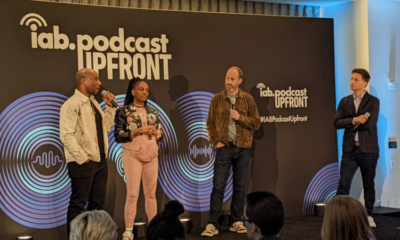



You must be logged in to post a comment Login